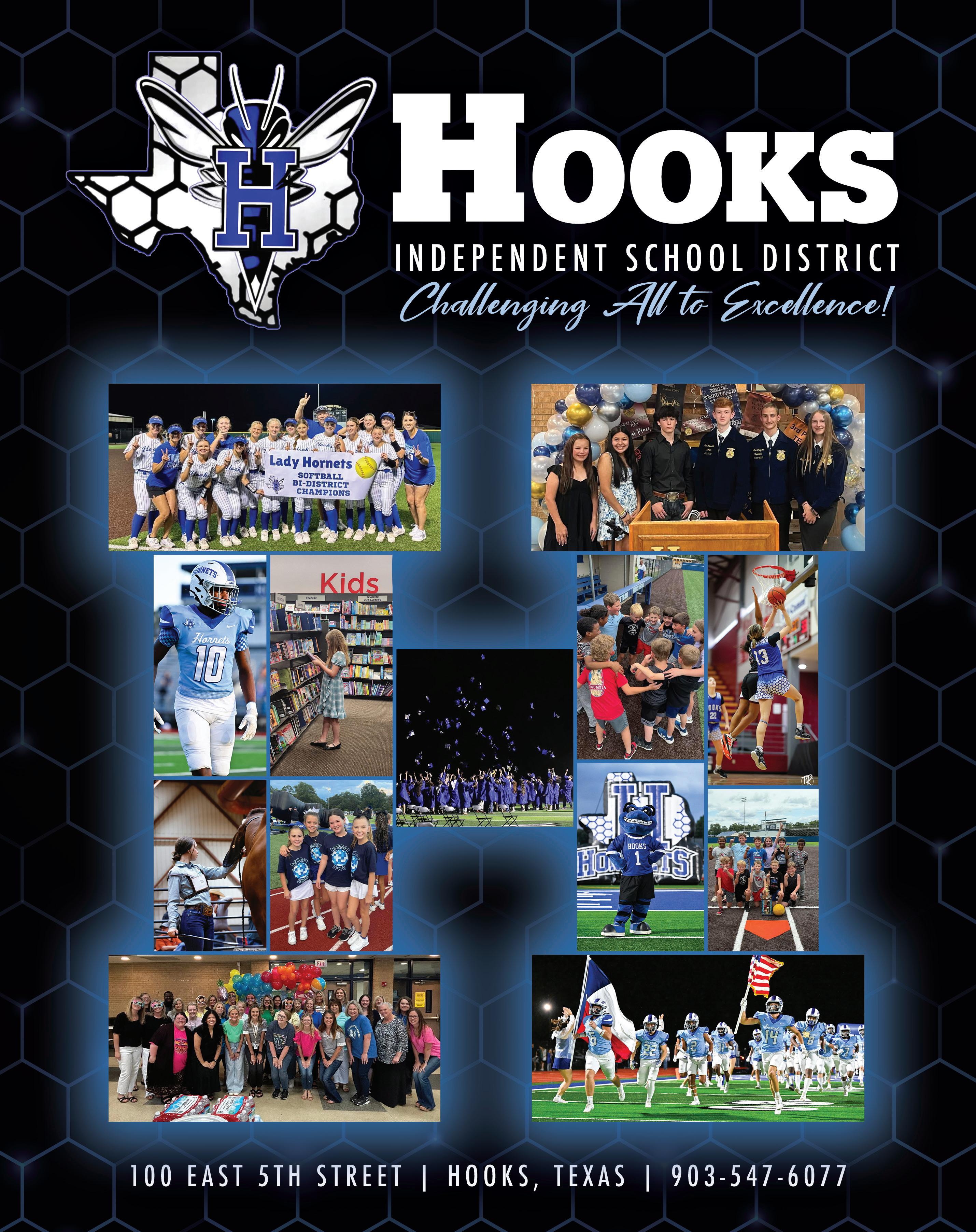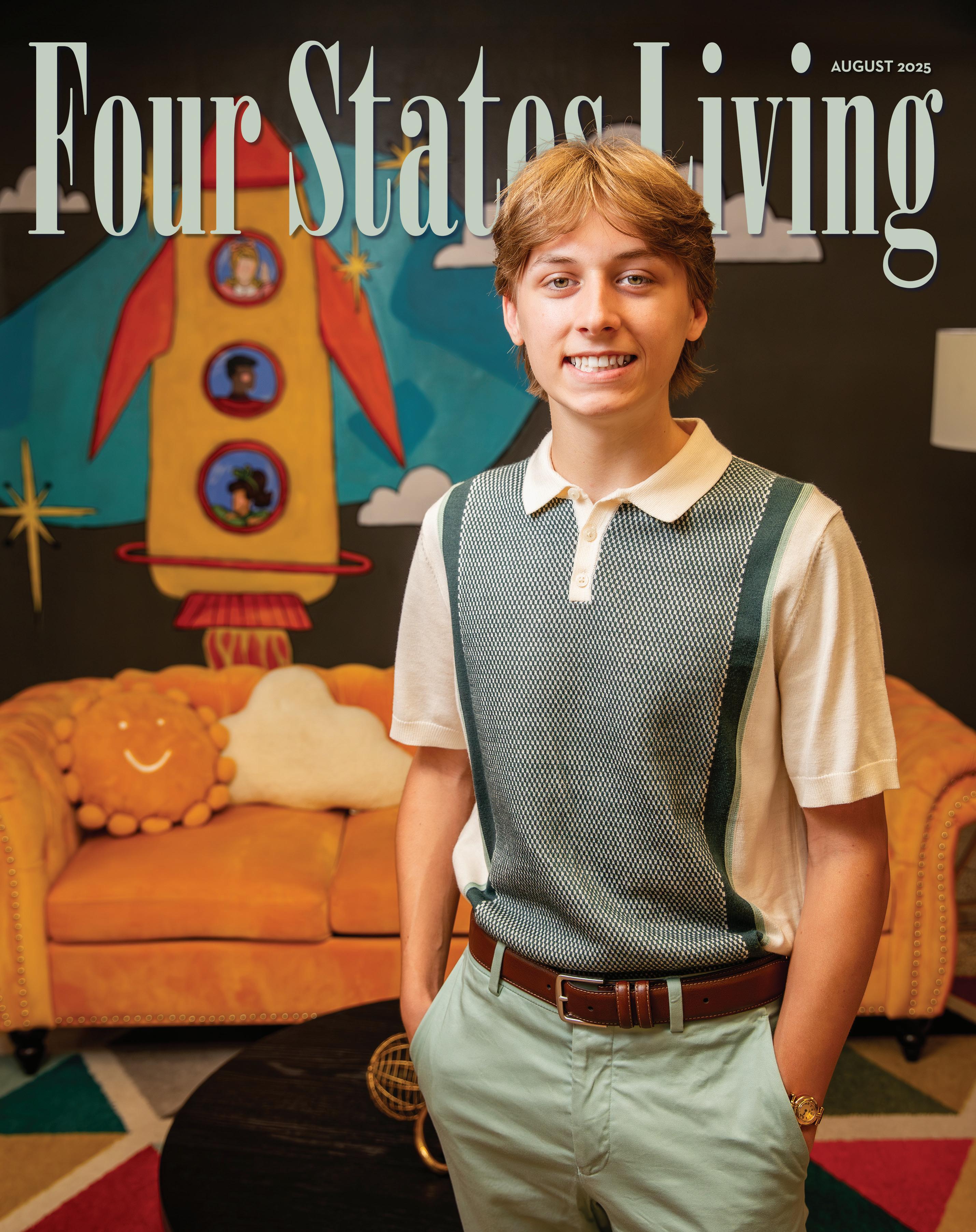












Robin Rogers, Ed.D.
t’s late July, and as usual, I have waited until the very last minute to pen my thoughts that relate to the August issue, our education issue. I am the greatest procrastinator of all. Everything on my to-do list gets priority before I will make myself sit down and write. I don’t actually think I’m a great writer, so if there’s a yard to mow, dishes to do, or 15 loads of laundry piled up, those chores will take priority over writing. For the last week, I have been packing and preparing for a girls’ trip to Alaska. Every day, my list grew longer and longer than my desire to write. At this point in my life, it’s almost too exhausting to even try to vacation anymore. Between wheelchairs (yes, plural), electronics (including this Mac on which I type), clothes, snacks, and medicines, we haul so much stuff. When we finally got to our seats on the plane, I was pooped out. I knew I needed to write my editorial before we descended on the West Coast, but, sandwiched between a woman who wouldn’t stop talking and some kids who didn’t hear the flight attendant say that devices with sound are fine as long as all passengers wear their headphones, I was really doubting my ability to concentrate. Back in the Four States Living office, my designer was probably tapping his feet, wondering why he had everything ready to go to press, and I couldn’t get my act together. “I’ll write it from the plane,” I had told him, as if some divine inspiration would permeate my brain at 45,000 feet. That’s never the way it goes, though. To get busy writing means doing the hard thing—opening up the computer and just starting to write.
I’ve never met anyone who truly enjoys writing; oh, I know those people exist, but I really don’t know any. For many years, I taught writing on the college level, and I remember so many students who had put off taking the one required junior-level writing class until the semester that they were supposed to graduate, praying to the syntax and grammar gods for a lenient instructor. Again, I don’t consider myself a great writer, but I can teach students how to mimic better writers, and I’ve always encouraged people to practice telling their own stories through their fingertips. “If you can tell a story, you can definitely write it down,” I would say. “Good things take time and practice.” I can still hear the moans of disbelief.
Do you remember the wobbly feeling you had when your parents first reluctantly took the training wheels off of your bike? You knew you were going to fall; that was inevitable. But after more tries and peppier encouragement,



PUBLISHER
Dr. Robin Rogers
EDITOR
Ellen Orr
GRAPHIC DESIGN & PHOTOGRAPHY
Shane Darby
SALES REPRESENTATIVE
Victoria Herman
EDITORIAL ASSISTANT
Phoebe Warren
you found that two-wheel stability. It took practice. Everything worth doing takes practice. Even those people with “natural talent” stay the same without practice.
I’ve been in the magazine business for almost three decades. A few years ago, I felt like I was cruising, as I rested on my laurels and stopped trying to improve. I think that happens to many people who do the same job for a long time. My favorite teacher used to say, “If you are sitting still, you are going backward.” He meant that, while you pause in anything you do, others are passing you. When COVID happened, for a hot minute, I worried that my business might crash; plenty did during the shutdowns. I kind of lost my mojo and wondered if I was doing what I was “supposed to” be doing. I contemplated selling. Was I going to choose the safe path, change directions, or step on the gas? I’ve been working (paying taxes) since I was fourteen. The idea of a safe path sounded good, but I knew it would not bring me joy. I need to learn, be challenged, and grow. This magazine is my passion and legacy, so making sure it can thrive for the next owner—when I am ready—is the most important growth I can practice.
Recently, I visited with a dear man who is knocking on ninety years old. We talked about his business, from which he retired almost 30 years prior. He ran one of the biggest, most successful businesses in Texarkana for decades, but he said that he learned the most after he retired. “How is that possible?” I asked.
“That’s when I took up reading,” he said, “and now I read every day. And I read all kinds of things.”
He proceeded to send me an article from The Wall Street Journal about the different clouds in outer space, something I’ve never even considered. Rarely do I think of an education beginning at retirement, but he was dead serious. That visit with him helped me turn the corner. I’m not finished learning and growing. Time is a thief; if we don’t seize new growth opportunities, what’s the point?
You don’t have to write, or read more, or ride a bicycle, or golf, or paint, or teach. You don’t even have to reinvent yourself. But, “if you are sitting still, you are certainly going backward,” and nobody wants to have to put the training wheels back on when you’ve had the freedom of the wind in your hair riding a bike downhill.
Learning is everything. It’s one complementary thing that our country provides (at least K-12) and people take for granted. My young friends these days are so busy trying to fit classwork into a school week and every possible extracurricular activity into that same timeframe. “Do we take regular, pre-AP, or college-level English?” “How many dual-credit courses can we earn before high school graduation?” “How fast can I graduate?” “I can’t wait to settle down and get a job with a car payment.” To my younger friends: slow your roll. There is no award for the fastest to leave school. You have many years to work. Sample the curriculum, and find your passion. Train with people who are invested in your success. And try not to sit still. The world is such an interesting place.
This month’s issue is our annual education issue. Every story spotlights amazing people, younger and older, who love what they are doing right here in the four states area. Read these stories, and I guarantee you will learn some new things! And, as always, thanks for reading FSLM
CONTRIBUTING
PHOTOGRAPHERS
Truth Dukes
CONTRIBUTING WRITERS
Emily Gammon
Alex Hartline
Jennifer Jordan
Baylor McLelland
Lindsey McMillan
Ellen Orr
Brandon Shoemaker
Phoebe Warren
Four States Living Magazine is published the first business day of every month. © Copyright 2025 by Four States Living Magazine. No part of this publication may be reproduced in any form without written permission of the publisher. Four States Living Magazine is distributed free of charge. Direct mail subscriptions are $40.00 per year. Reader correspondence and editorial submissions are welcome. We reserve the right to edit or reject any material contributed.
Do You Have a Story or a Photo?
We welcome information regarding topics of interest for future publications. If you have a story or photos that in some way depicts living or visiting in the Four States area and would be of interest to our readers, we want to hear from you. Call 903-792-2262 or write: Editorial Department, Four States Living Magazine, 4104 Summerhill Square, Texarkana, Texas 75503. Comments are also welcome at our e-mail address: info@fourstatesliving.com
Want to Advertise?
Advertising rates may be obtained by contacting the Sales Department at 903-792-2262, writing to Four States Living Magazine, 4104 Summerhill Square, Texarkana, Texas 75503, visiting our website www.fourstatesliving.com or emailing our Sales Department at info@fourstatesliving.com


Brody Fincher, a senior at Queen City High School, has cultivated a passion for all things artistic. Along with his mother, an interior decorator, he uses his eye for design to beautify his campus and community.
Read about Brody on page 10
Beloved teacher Monica Washington, who was inducted into the National Teachers Hall of Fame in 2023, continues her career in education as the newly appointed Director of Teacher Quality for the National Education Association.
about Monica on page 32
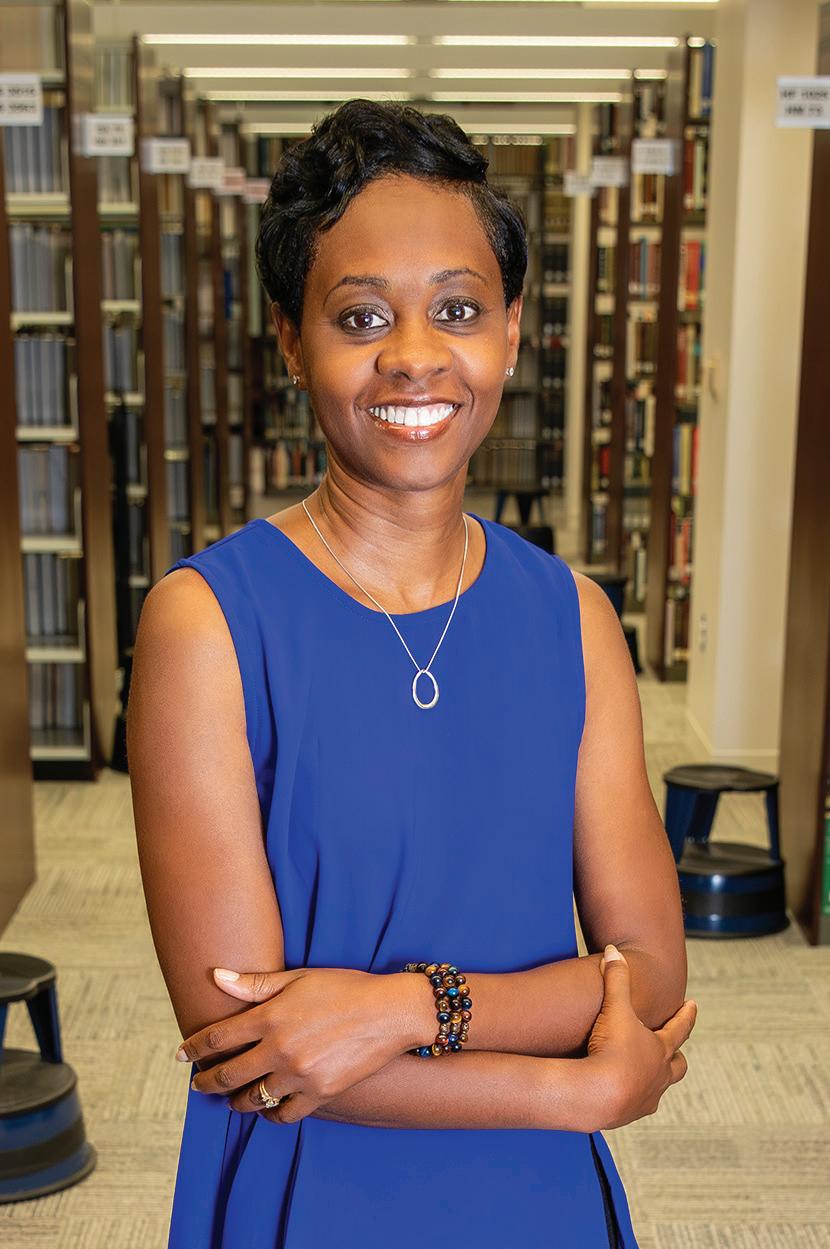


With art and design, senior Brody Fincher revitalized his campus
by ALEX HARTLINE
Brody Fincher fell in love with art as a child and has pursued it relentlessly since. Currently a senior at Queen City High School, he has made a name for himself on campus through his artwork.
“Beautiful things always captured my attention, and I was drawn to the subject [of art],” Brody said. He also has several family members who were involved in the arts who helped to encourage his interests. In particular, his mom, who is a painter and interior decorator, has influenced him to grow his art from a hobby to a professional skill.
They now work alongside each other to transform spaces with new art and interior design.
Brody’s first professional job was helping to redesign and redecorate the assistant superintendent’s office, located within the Queen City ISD administration building.
“My mom was hired to paint and revamp the office, and she wanted some works of art from me incorporated,” Brody explained. “[The superintendent] loved it so much, [and] it grew from there.”

I love everything designrelated, from architecture to fashion. “ ”
photo by SHANE DARBY
Soon after, administrators from J.K. Hileman Elementary School reached out to have Brody and his mother transform their basic gray foyer walls into something that would make the students feel excited to be at school. He spent countless hours during the winter break of his sophomore year painting the elementary school foyer to have it completed before students came back for the new year. It wasn’t only the time crunch that kept him determined. “It’s seeing their reactions that drive me to create something they want,” he said. His dedication to his craft has just as much of an effect on the students as the artwork he created for them.
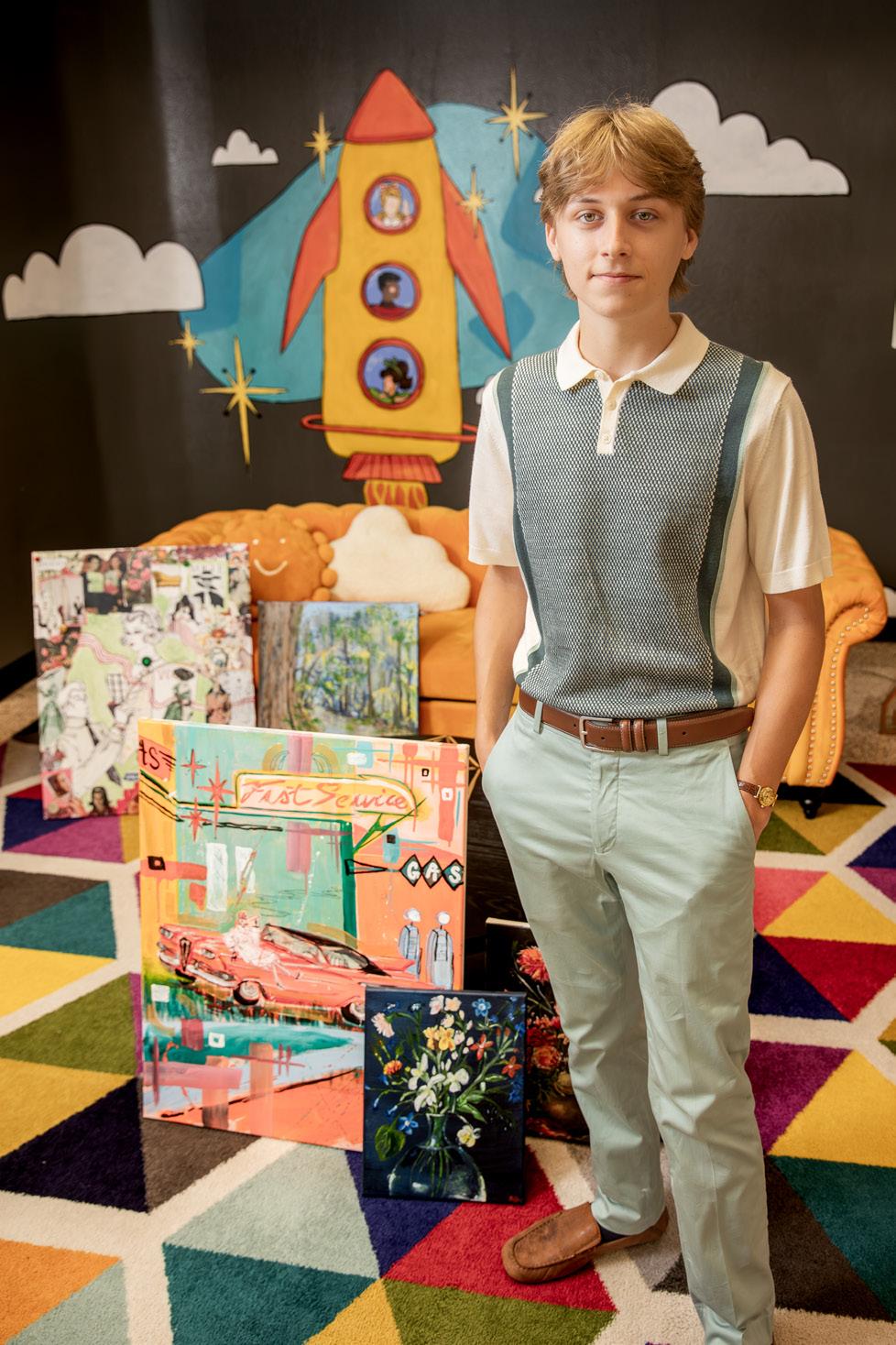
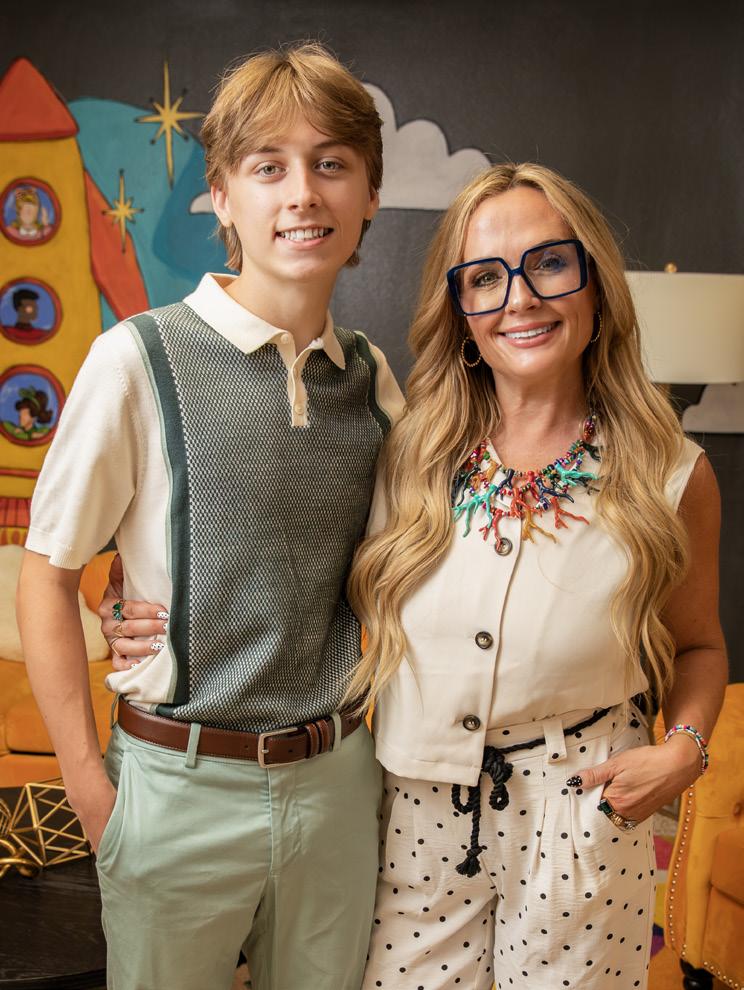
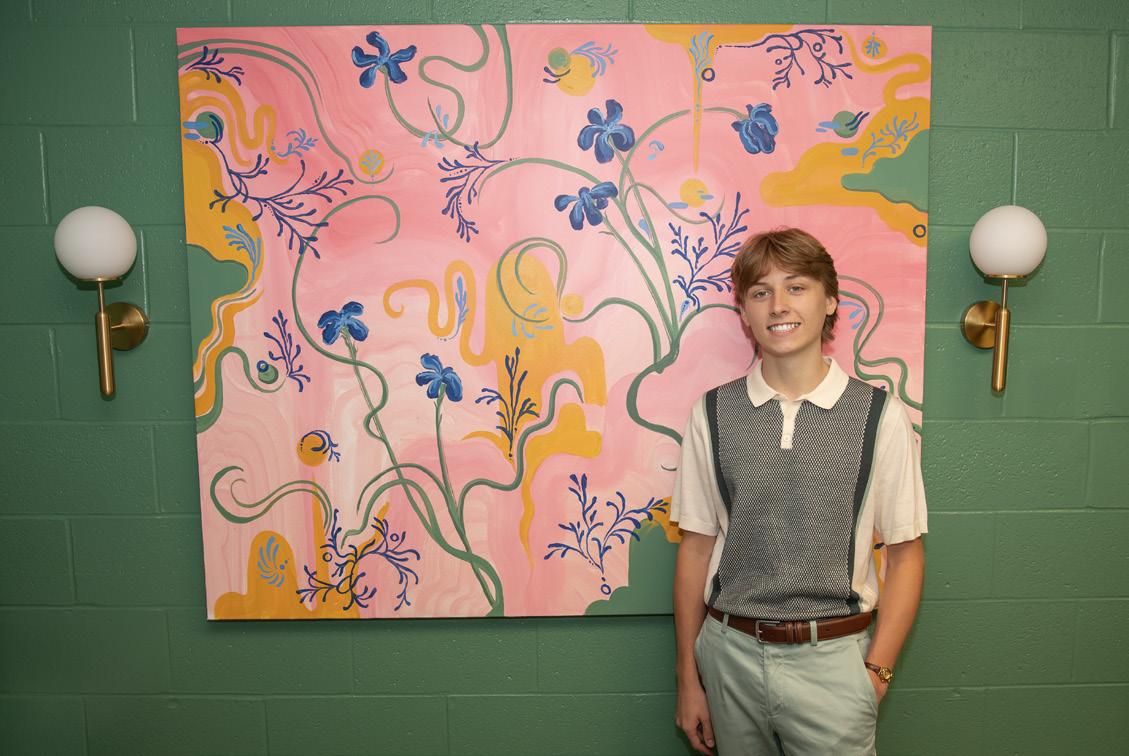

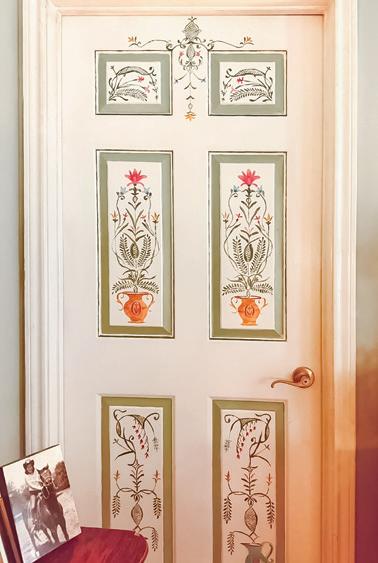
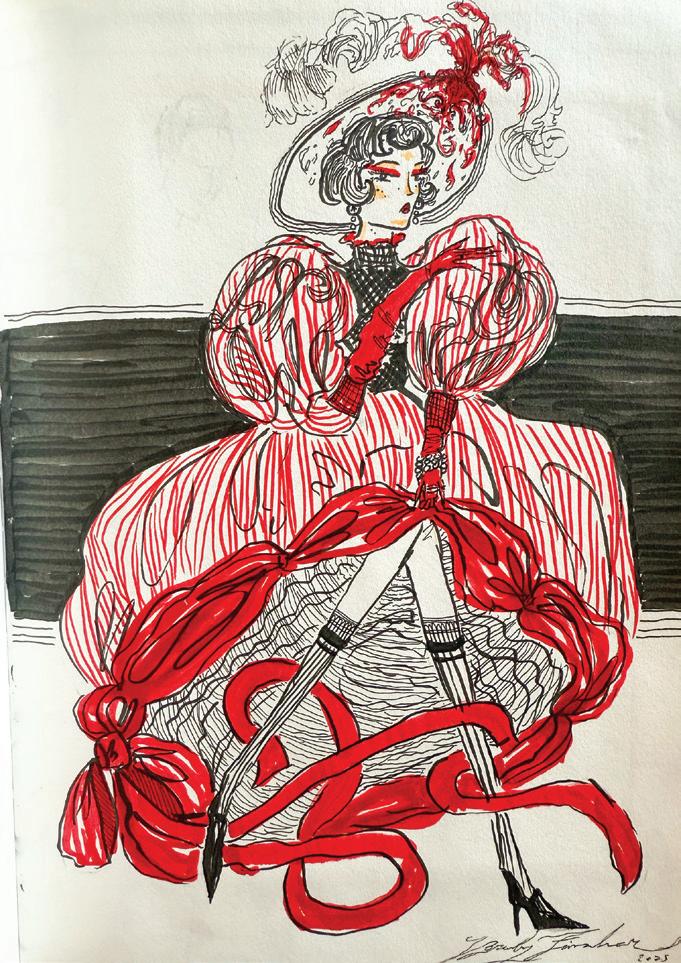




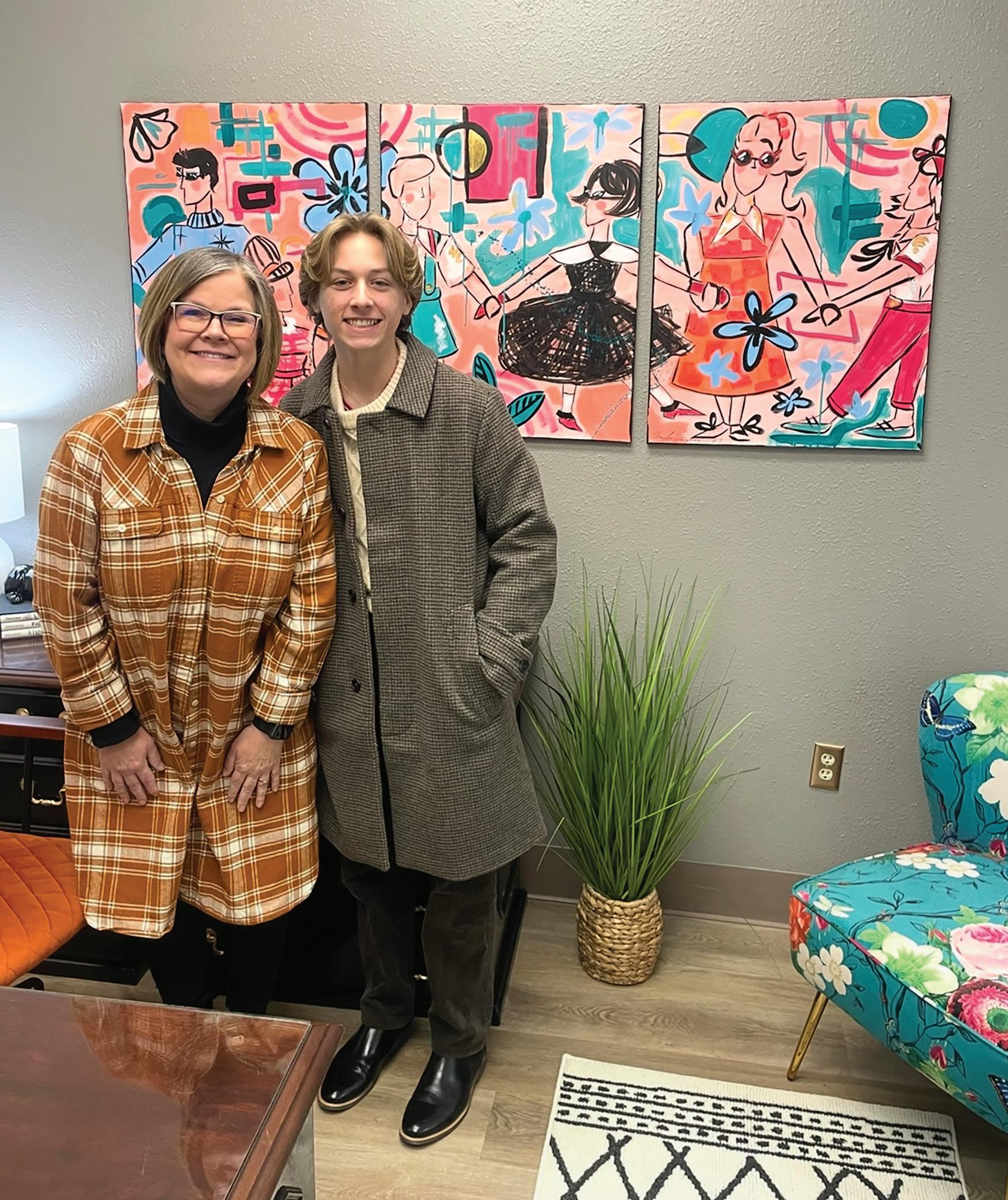
Painting is not the only art form Brody is skilled in. “I love everything design-related, from architecture to fashion, and keep pages upon pages filled with designs that will hopefully one day be a reality,” he said. He also has a love for antiques, reads the classics, and appreciates music of all types, though he’s partial to Julie London and Billie Holiday in particular. He even plays the piano. These other forms of art, he said, inspire his own creative expression. When he’s not holding a pen or paintbrush, he can be found enjoying hot Earl Grey tea in the afternoon or taking his dogs on a walk through the woods in the evening.
Looking to the future, Brody has plans to attend an art institute where he can further pursue his passion for the arts in all their forms. He has certainly left his mark on Queen City ISD and will continue to inspire students who walk past his artwork for years to come. Not only does it create a safe and inviting atmosphere for them, but it also serves as a reminder that the creative arts are for everyone.

“For anyone younger interested in the arts, I would let them know how important it is to let your personal interests come forward, no matter how odd they seem to others,” Brody said. “Art is not just in a paintbrush touching a canvas, but [it is] in almost everything, from sports to arranging flowers in a vase. You will always find a hidden meaning in everything you see and do, and if you put your heart into it, it is your art.”




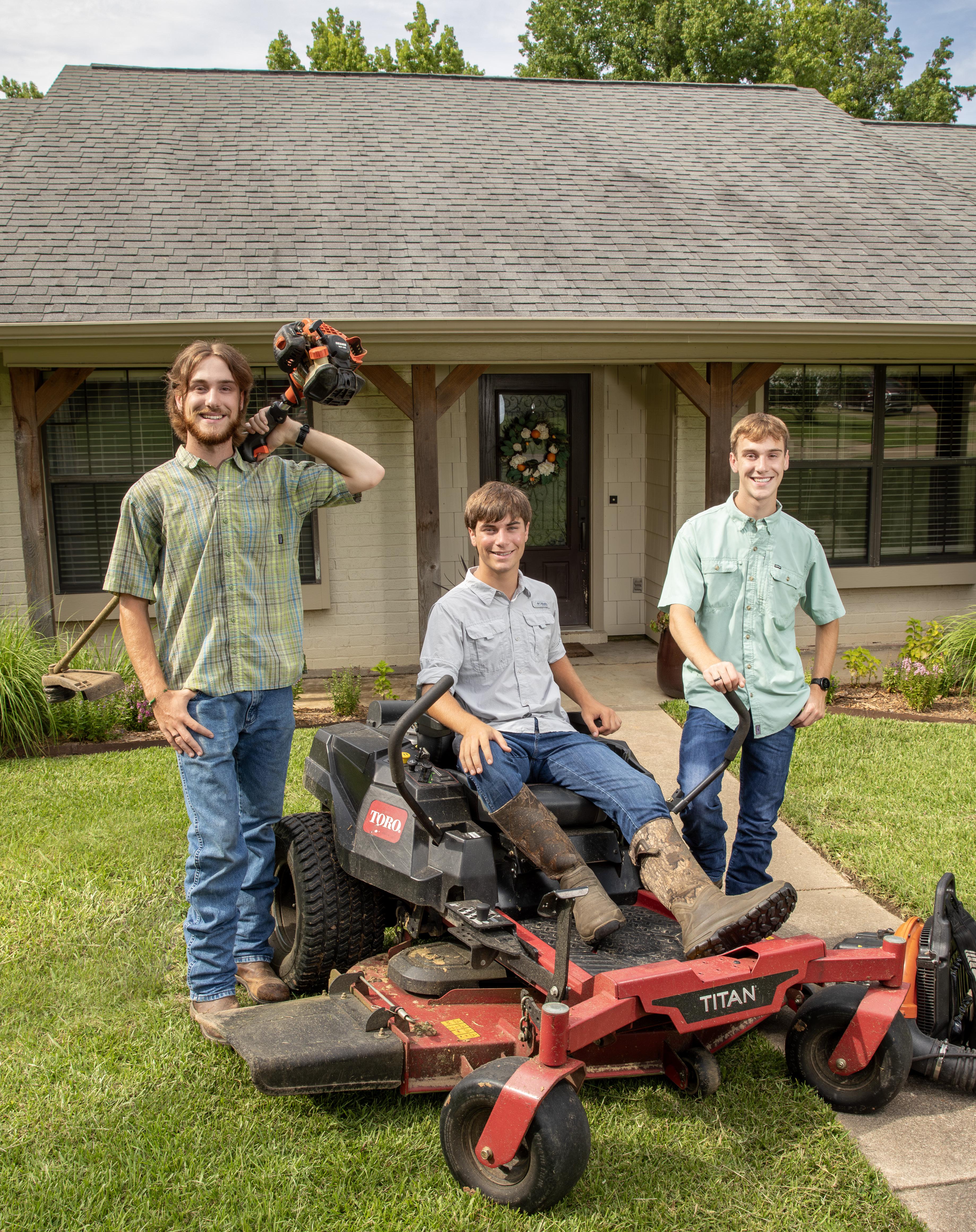
by PHOEBE WARREN
Before most of their peers have even stumbled out of bed, the White brothers have already mowed half a neighborhood. What started as a remedy for boredom during the memorably sluggish summer of 2020 has snowballed into six seasons of lawn care for Jeb, Chapman, and Harrison White. “We mainly mow, but we do [also] offer light landscaping and bed work,” Chapman said. “We started doing yards with our parent’s lawn equipment but have since invested about $7,500 in purchasing our own equipment.”
The brothers give credit to their dad, Justin White, for getting them started. “He made the first steps in starting our business by posting our desire to do yard work for those in our neighborhood,”
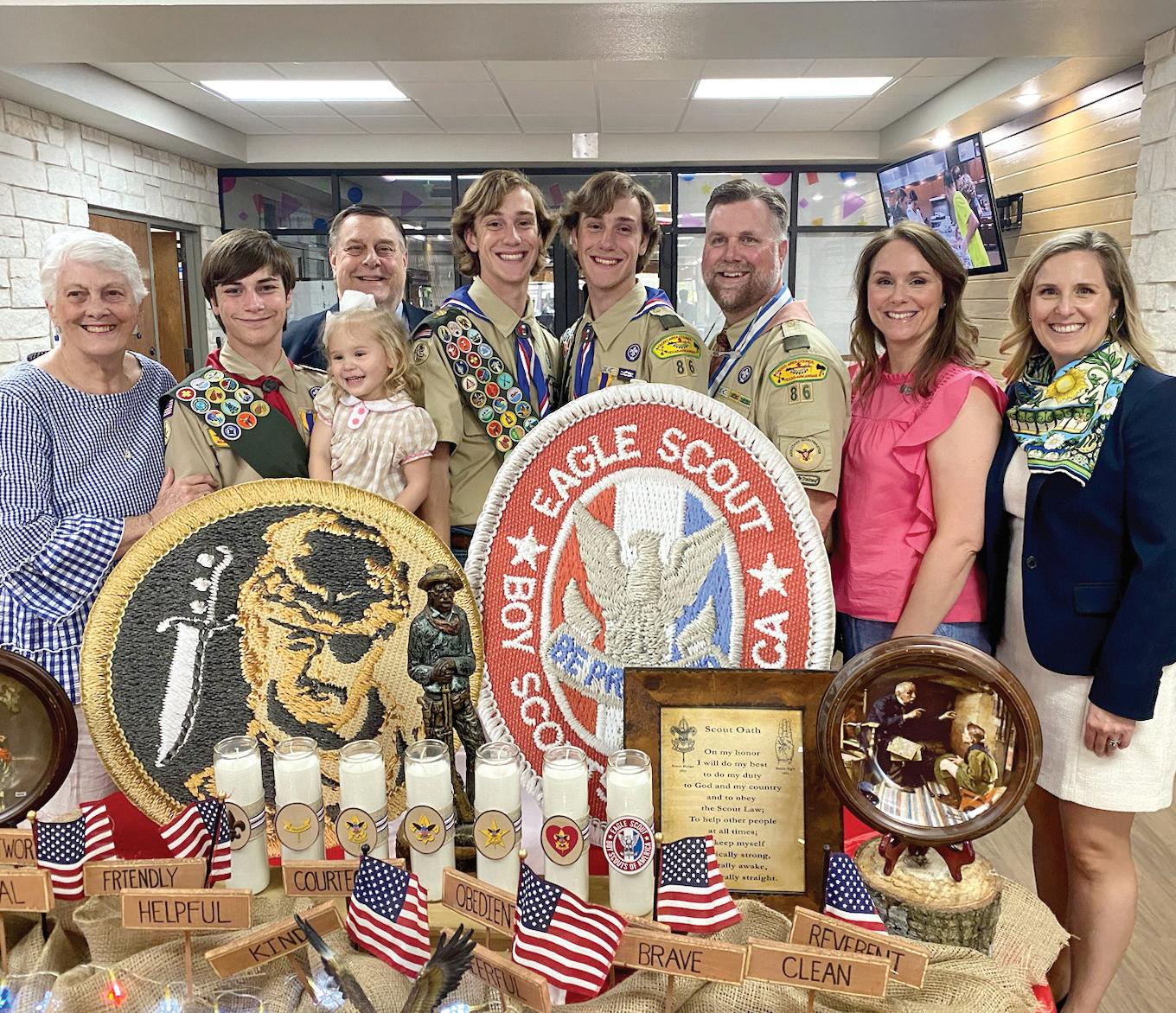
Chapman said. “We started with our neighborhood since none of us had driver’s licenses at the time we started. We now all have licenses and can efficiently and safely manage our 14-foot trailer.”
A typical work day for the brothers begins quite early. “We wake up by 6 a.m. and get to the first yard at 7,” Harrison said. “Depending on other obligations, we complete somewhere between one to nine yards.”
The brothers collaborate to oversee all aspects of the business. Each brother lends his own unique strength to make their operation a success. Chapman is credited as the group’s star communicator with customers. Harrison is the motivator of the trio, being the first to get
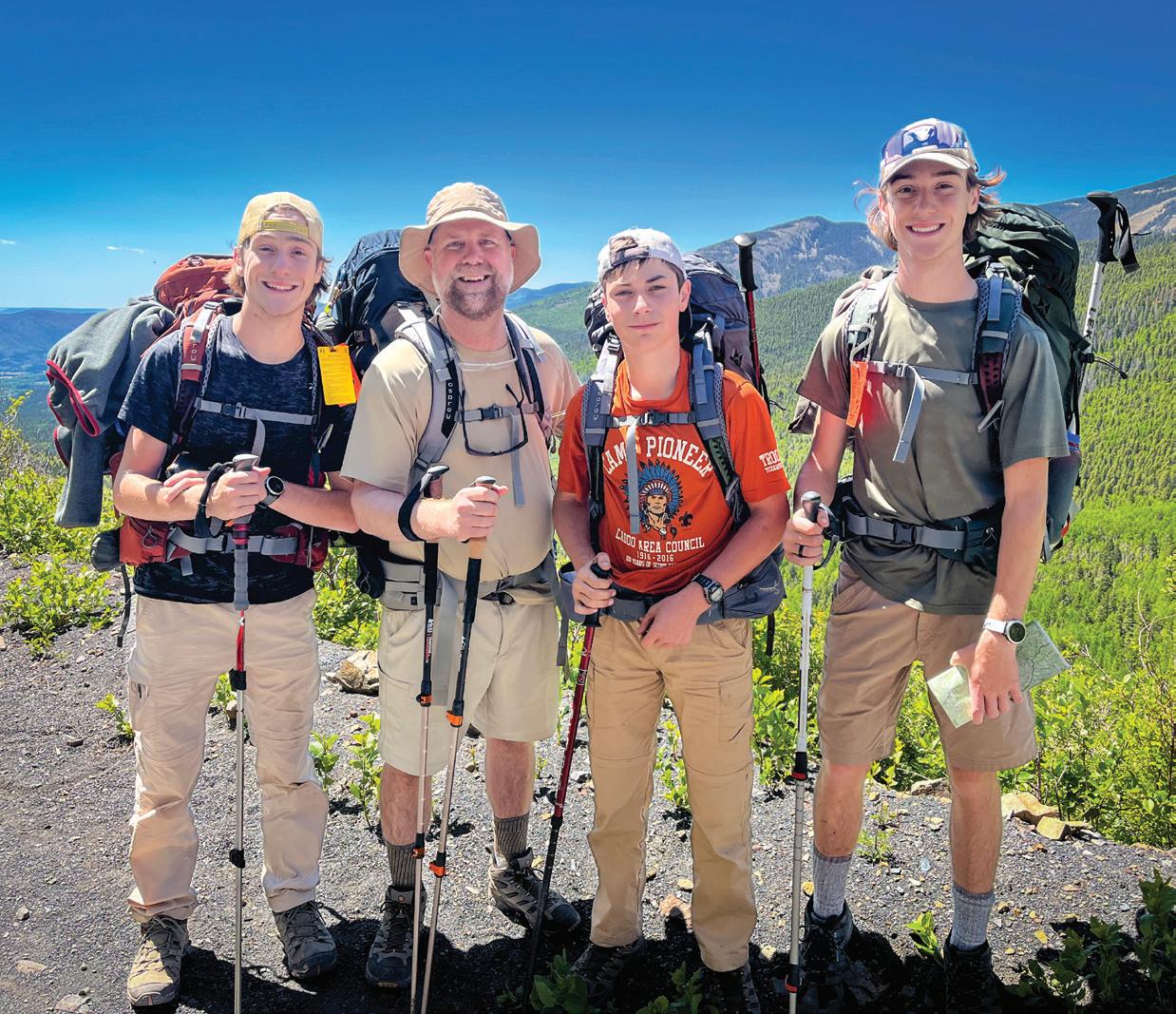


up and get the equipment loaded, encouraging the group to tackle the day’s work. Chapman and Harrison both said that Jeb “doesn’t mind doing the dirty work,” making him an invaluable asset to their business. Collectively, all three engage in various yard work tasks, including mowing, weed eating, edging, and utilizing a blower to clear leaves and debris. “It’s a messy job, so we’re all covered in sweat, grass clippings, and dirt when done with jobs,” Jeb said. “Weedeating ditches is an especially dirty job.”
Chapman said working together is probably easier with family than working with strangers. “You can be honest with one another,” he said. “When there are disagreements, we settle them between ourselves and try to find a middle ground.”
The brothers generally work together with ease. “When there are disagreements, we settle them between ourselves and try to find a middle ground,” Chapman said. “You can be honest with [family].” However, the landscaping business still throws plenty of curveballs.
“We were talking about someone on another lawn crew getting their mower stuck in the mud,” Chapman said. “Then we ended up getting ours stuck. Karma.” Harrison admitted that he has removed poison ivy from a yard and then absentmindedly wiped his fingers down his face, causing some major discomfort later. Jeb chimed in with his own tale of woe. “I jack-knifed the trailer one time and left a dent in my truck,” he said.
Luckily, the challenges of the work don’t put a damper on the brother’s enthusiasm, as they believe their landscaping jobs are laying a solid foundation for their future careers. “We understand how hard it is to make money,” Harrison said. “We treat our equipment well, since it is expensive to buy and maintain.”


Jeb said the business has instilled in each of them the important lesson of pride in one’s work. “We get satisfaction seeing the yard once it is completed, knowing we did a good job, and making the customers happy,” he said.
Even outside of work, the White brothers stay busy. Jeb and Chapman White, the elder twins of the trio, both participate in cross country at Texas A&M University–Texarkana, and Chapman serves on the Student Athlete Committee. Harrison, a student at Texas High School, is a member of the varsity golf team, Leadership class, and National Honor Society. Jeb and Chapman are Eagle Scouts, and Harrison is on-track to attain the title this year. The brothers believe that, despite being time-intensive, these extracurricular endeavors have been invaluable to their lawn care business by equipping them with leadership and communication skills.
Each brother has his own big plan for the future, and they are hopeful that the long hours of work now will pay them back tenfold. Jeb is pursuing a bachelor’s degree in forest wildlife management, aspiring to become a wildlife biologist. Chapman is aiming for a bachelor of science in nursing. Meanwhile, Harrison is focused on completing high school and intends to earn a bachelor’s degree in finance.
The White brothers provide the perfect inspiration for any other young aspiring entrepreneurs in the area. In true brotherly fashion, they have come up with their “checklist for success”: network with your parent’s friends and colleagues, manage your time, set goals, and work hard.

by BAYLOR M c LELLAND

s August begins, so do preparations for the incoming school year: gathering supplies, buying clothes, and memorizing the new schedule. On top of that, seniors have to prepare for the end of their high school journeys, and for some, their journeys as athletes. For Pleasant Grove High School’s Lynleigh Henderson, this month represents all of that and more.
Lynleigh began playing tennis in sixth grade as a way to avoid taking a P.E. class. “Tennis was the only other option, so I signed up for it,” she said, “and it took a while, but I ended up falling for it.” It was during her eighth-grade year when she started to take the sport seriously. She began taking private lessons at Northridge Country Club to improve. Since then, Lynleigh has gone from an amateur—who hadn’t even held onto a racket before—to one of the school’s best players. She is beginning her senior year in the number-two position in the girls’ tennis division.
“I have learned how to spin the ball when I serve and do all these things that sixth-grade me would have been so confused by,” she said. However, she emphasized that physical skill alone is not enough to be a successful tennis player. “Tennis is a game where you have to know the strategy to win.”
Lynleigh used her skills and strategy to climb the ranks to number six in the girls’ division her freshman year and nearly competed on the state level as a freshman. However, at the regional competitions, Lynleigh lost her match—and lost her team the chance to compete at the state competition. While the results took a toll on Lynleigh, she used the event as motivation through her sophomore year. As a 10th grader, she faced the same opponent at regionals, and again she lost. Lynleigh did not give up, though, and this past year, she finally beat her. This relentless willpower is Lynleigh’s greatest strength, allowing her to be where she’s at today.
Lynleigh said that her willpower is fed by encouragement from friends and family but that her biggest motivator is a desire not to let her team down. After her lost matches at regional competitions as an underclassman, she worked tirelessly to beat her opponent this past season. Through her mistakes and the adversities she and her team have faced, she’s grown as a player and person.
Through tennis, Lynleigh has also built unexpected relationships. During practice, players with different lifestyles and beliefs get to bond and learn about one another. “Just being with each other every single day at practice, you’re going to form relationships,” Lynleigh said. “On our bus
rides and overnight trips, even though we’re different, we all find ways to talk with each other.” These relationships have helped build a family of Pleasant Grove’s tennis team.
Now, as this group prepares for their final year together, some goals have been set to “go out with a bang.” Lynleigh expects to win most of her matches in the fall season, as she said, “That’s just how it’s going to go.” During the spring season, she’ll increase her number of lessons, practice as much as possible, and set personal goals to find a balance between tennis and celebrating her senior year.
While a student’s senior year is an emotional one for families regardless, the Henderson family is closer than average. Lynleigh’s younger sister also attends classes at PGHS, and their father works

as the school tech supervisor. On some occasions, he’ll have to come into one of Lynleigh’s classes to solve a technical issue, but before he solves it, he has to make it known that his daughter is in the room, embarrassing her in the process.
With her family, friends, and fellow tennis players supporting her, Lynleigh is beginning her senior year with energy and excitement. “It’s nonstop tennis from now ‘til May,” she said. “I’m going to sleep with my racket in hand.” However, while this sport is something Lynleigh is passionate about, it isn’t her main focus. She hopes to attend Texas A&M University in College Station after graduation, where she plans to study business with enough time to play tennis for fun.
Despite the setbacks in her career, Lynleigh has shown nothing but growth as a tennis player. Even when she thought of quitting altogether, she held onto her dreams and racket, and she encourages other players to do the same. “Stick with it,” she said. “If you don’t stick with it, what else are you going to do? It’s worth it in the end.”



CAMP CREATE! WAS HELD AT THE 518 PINE LOCATION OF TRAHC FROM JULY 14TH THROUGH THE 16TH.
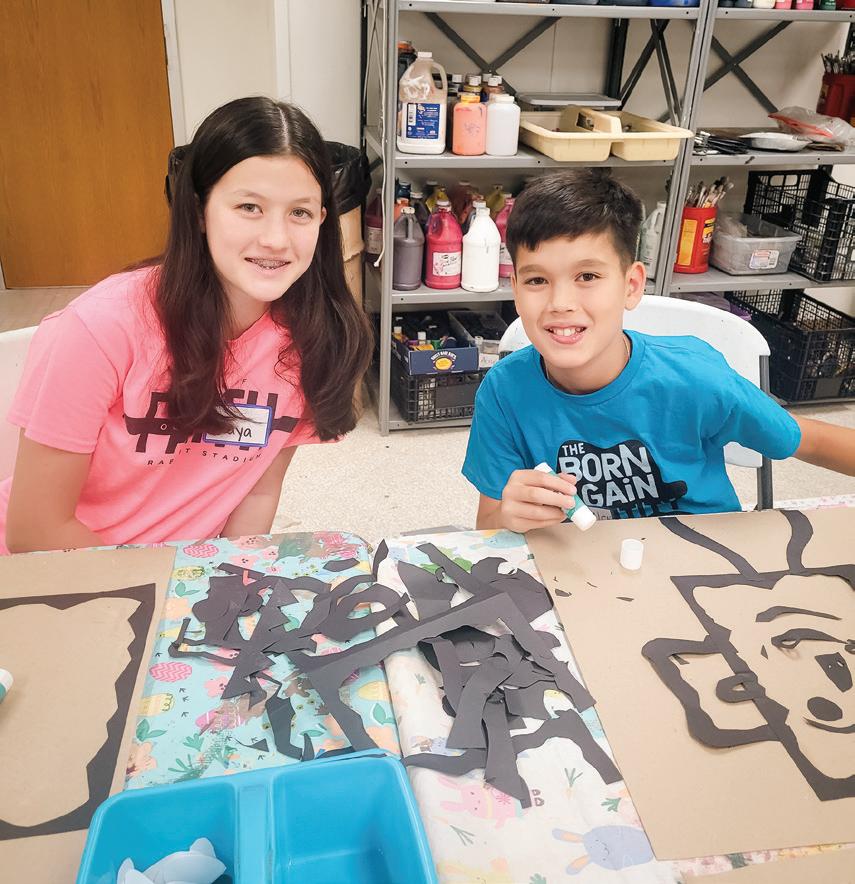
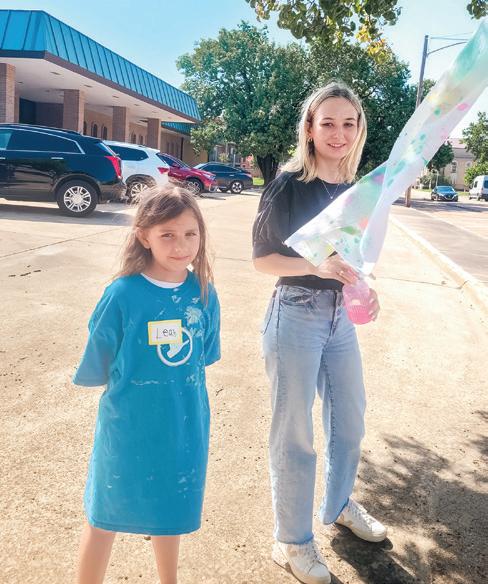
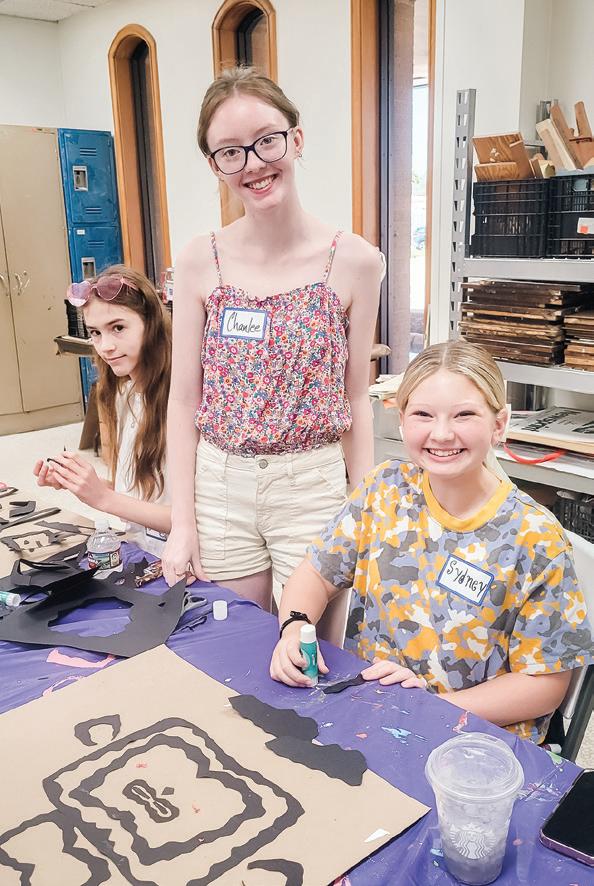

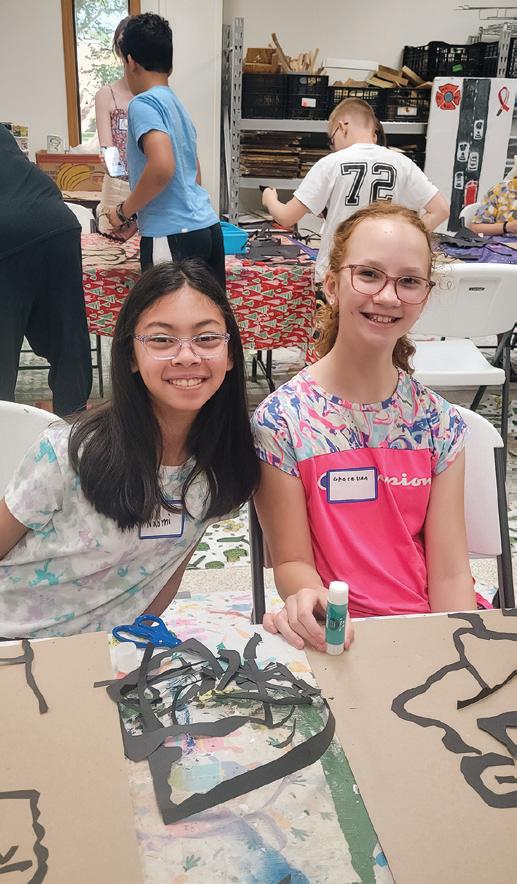

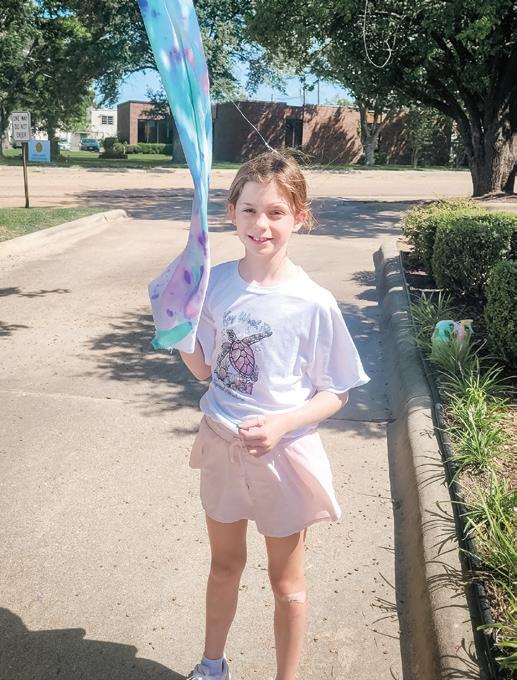
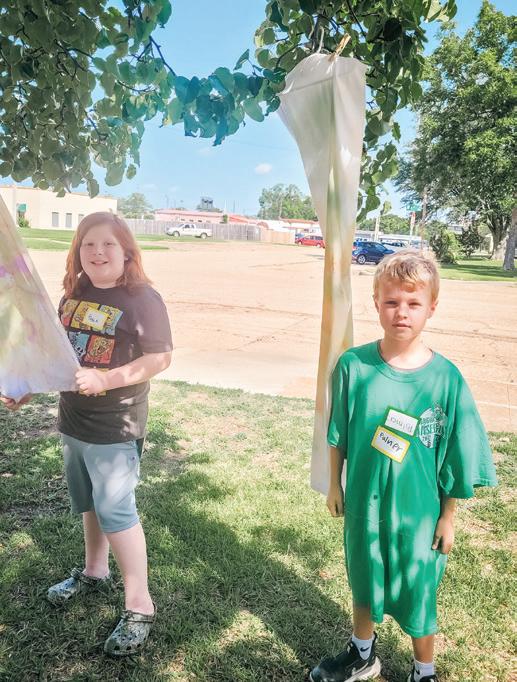



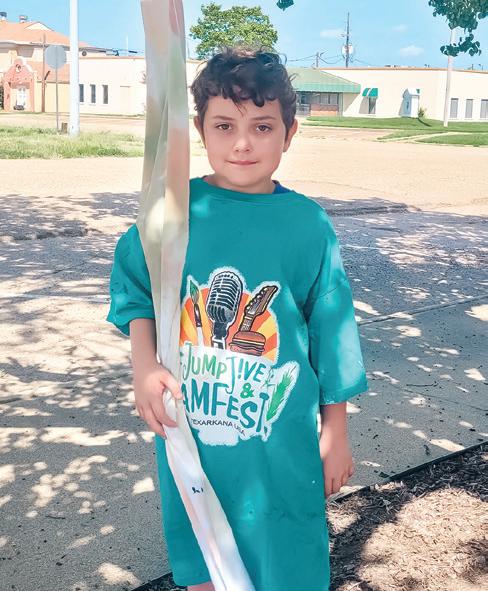


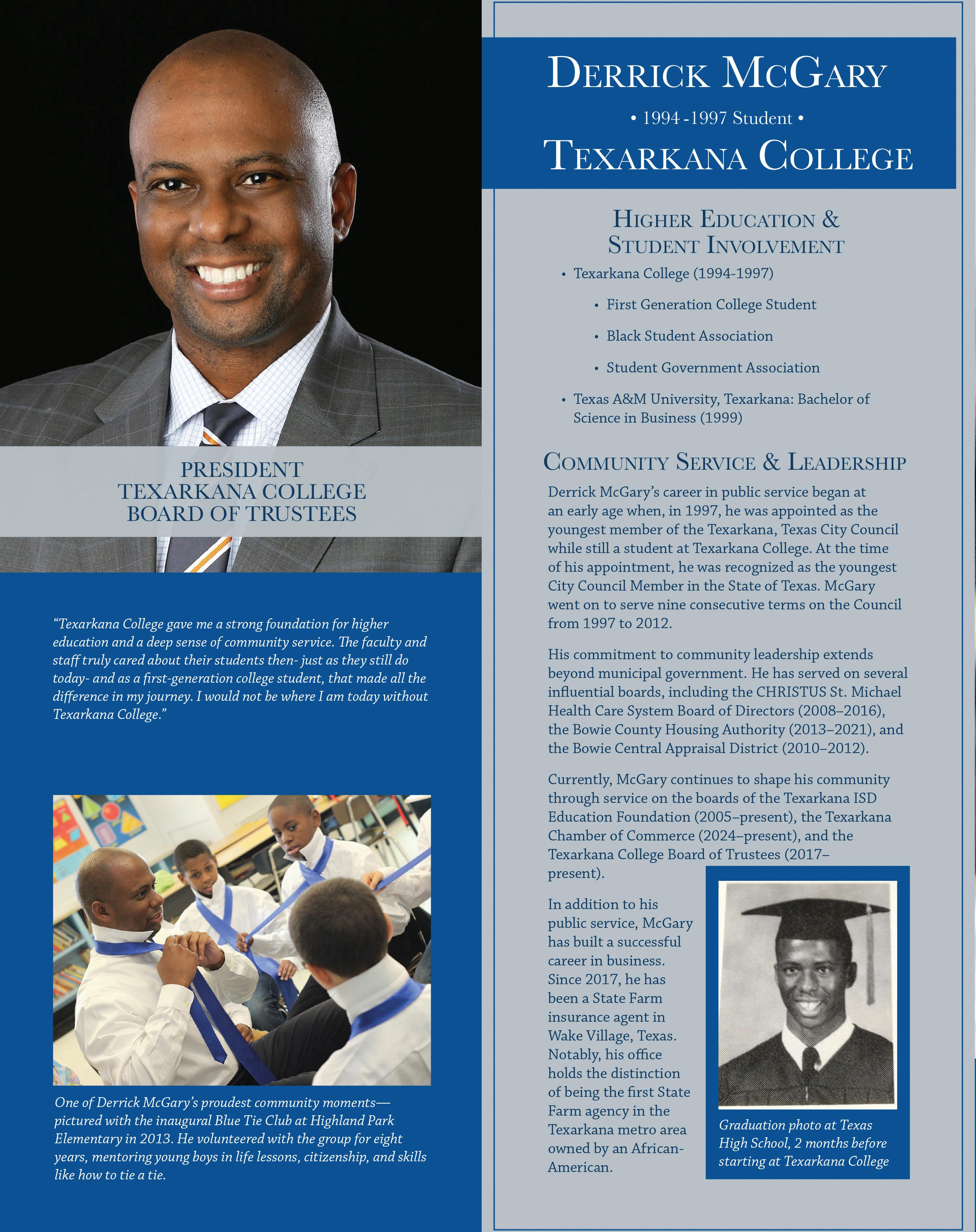
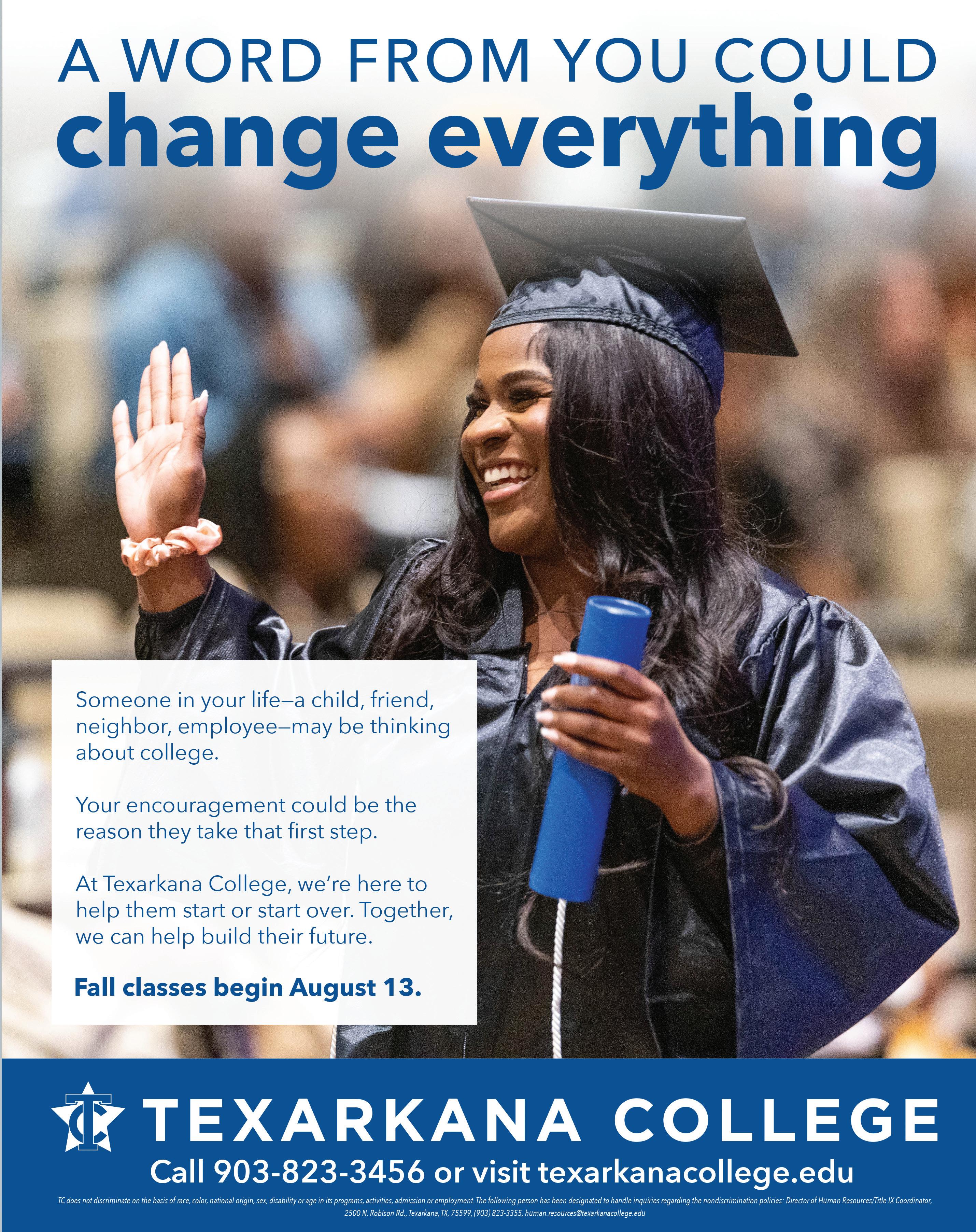
Lindsey
McMillan and others recount memories of Camp Mystic
by LINDSEY M c MILLAN

There’s a camp on the Guadalupe River. It s the camp of my dreams.

There’s an old camp song that ends with, “Camp Mystic, I will pledge my true and faithful love to you.” As locals share stories about the beloved summer camp they called home for years, it is clear that the pledge is more than a lyric. This blissful summer haven was struck with tragedy when floodwaters rushed through in the early morning of July 4th, 2025. Usually, the Guadalupe is calm and clear, gently lapping the edges of centuries-old cypress trees that grow alongside its banks. Many summer camps dot the landscape along Highway 39 in Hunt, approximately 18 miles outside of Kerrville, Texas. Camp Mystic is one of those camps, set to celebrate its 100th birthday in 2026.
Many traditions still exist from 1926, which mothers, daughters, granddaughters, sisters, aunts, and cousins have carried across generations. Former campers stretch across the state and beyond, all recently connected by their grief for the young people lost in the flood,
along with longtime camp director and owner, Dick Eastland. Dick and his wife, Tweety, served as surrogate parents to countless girls who attended the Christian camp each summer. Online, the fondest of memories are being shared, along with songs, stories, and photos. Kerr County suffered the worst of the flood, and many people are still missing from the riverbanks where they were happily celebrating a long holiday weekend.
Whether you’re lucky enough to experience this place for one summer or 15, these values stick with you forever.
–Sarah Grace Boudreaux “ ”
To process this grief, many former campers are sharing memories from Mystic, tucked neatly away in the Texas Hill Country, where limestone hills rise above the crystal water’s edge. This includes myself, as I spent 10 years as a Mystic camper and counselor alongside my sisters; my daughter, Emily, spent four summers there as well. We all have friendships we cherish and hold close. Dick Eastland was one of those friends, happy and full of smiles as he greeted the campers every summer. His family has continuously owned the camp since 1939, encouraging and challenging girls with three unchanging imperatives: “Be a better person for being at Mystic, let Mystic bring out the best in you, and grow spiritually.”

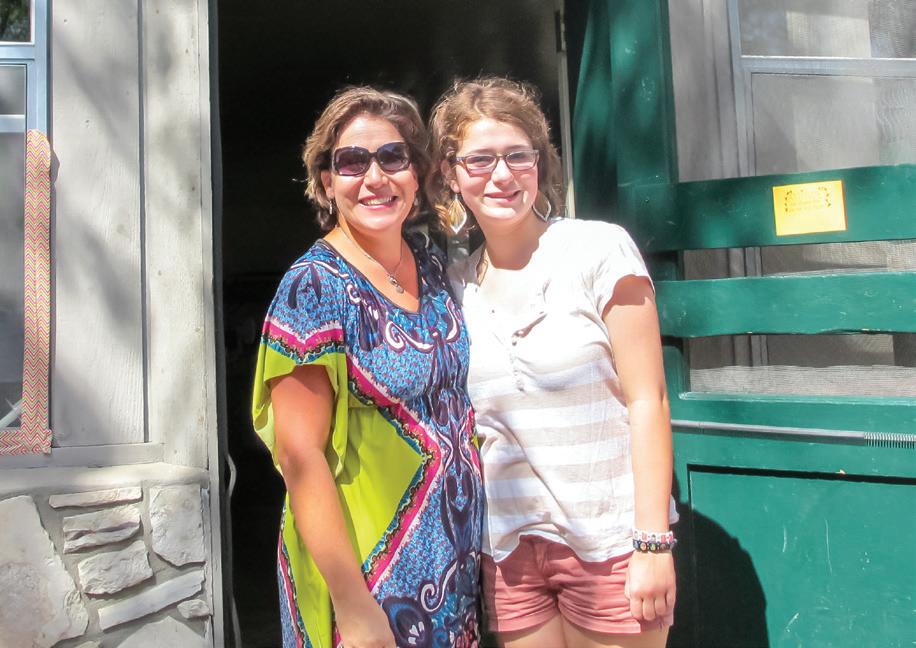
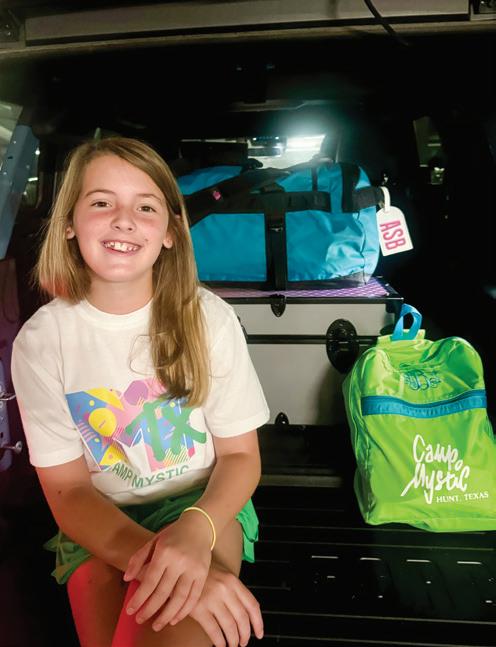
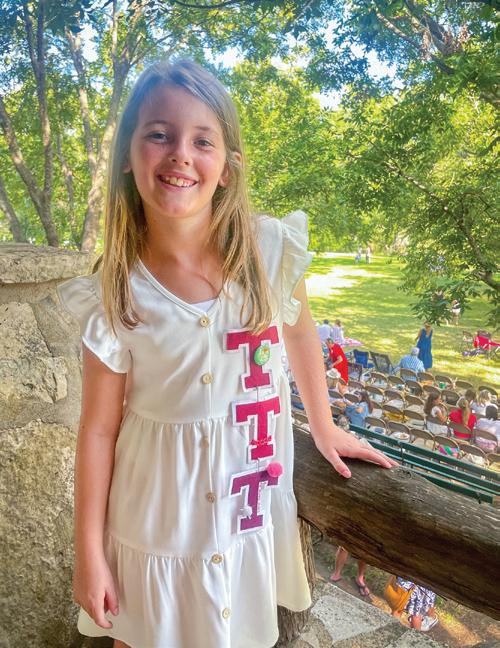



Camp Mystic’s website hosts a picture of their famous lighted sign, which illuminates the hills each night. Beneath the picture is the Bible verse John 1:5: “The light shines in the darkness, and the darkness has not overcome it.” In the darkness of the past few weeks, current and former campers have embraced this verse, keeping a light shining for this beloved spot.
Anna Scott Bruner, a 7th grader at St. James Day School, was scheduled to return to Mystic this summer for her fifth year, due to depart in a few weeks. “Two years ago, I won the Respect Award for my tribe,” she said. “I have been with the same 10 or 11 girls my
entire time at camp. Seeing the same familiar faces at camp every summer for two weeks is how we build such strong bonds.”
Elle Floyd, a recent graduate of Texas High School, attended Mystic for 10 years and just returned from being a first-year counselor in late June. To her, camp feels like family: “Mystic means so much to me,” she said. “It has given me my best friends, leadership skills, self-confidence, and patience, and it has helped me grow in my faith. Mystic is hard to explain to someone who hasn’t experienced the love within the green gates. It truly is our home away from home.”

Mary Claire Boudreaux Rippee, who spent 10 years as a camper and two years as a counselor, shared that her time at Mystic helped shape her. “Mystic was formative to who I am as a person, as a Christian, and as a friend,” she said. “It is heaven. Mystic means the world to me; it is my heart, and I hope it can continue to be a generational treasure trove for young women across the country.”
Her sister Anna Catherine Boudreaux spent 10 years as a camper, two as a counselor, and one year as the Activities Director. “The camp and the Eastlands guided you to become a better person, a more compassionate friend, and a stronger Christian,” she said. “Every year, so many girls count down the days until they can return to those familiar green gates. It’s a feeling I know so many of us share. Once a Mystic girl, forever a Mystic girl.”
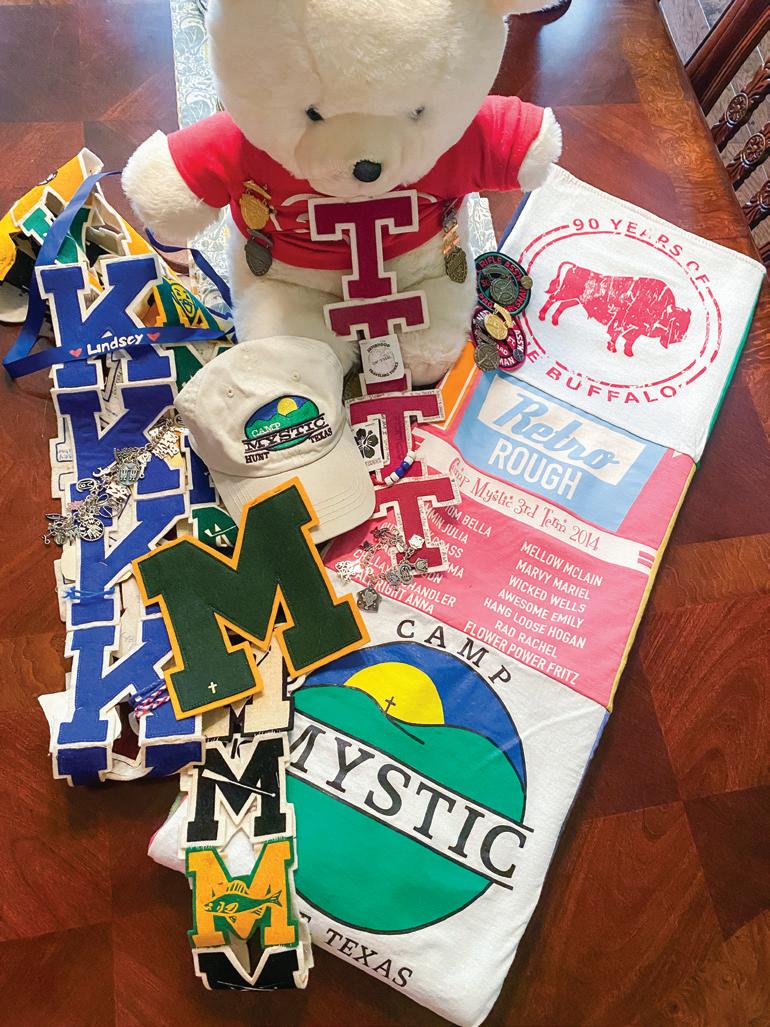
The youngest Boudreaux sister, Sarah Grace, spent five summers at camp. “Mystic teaches its campers to ‘be ye kind one to another,’ to ‘have the faith of a mustard seed,’ and that ‘love isn’t love until you give it away,’” she recalled. “Whether you’re lucky enough to experience this place for one summer or 15, these values stick with you forever.”
As we share these reflections of our happy summer home, we grieve alongside the families of the young campers and counselors who just weeks ago were celebrating summer and having the time of their lives. Former campers hold hearts and hands as we reconnect with friends both near and far. My friend Jessica Miller and I attended Mystic the same years, and she shared with me her memory of the magical scenery: “I always enjoyed the beautiful tree-lined Guadalupe River,” she said. “The waterfront was absolutely breathtaking, with steep, rocky cliffs on one side of the river and lush, green campgrounds on the other side. It was such a quiet, peaceful place where we felt happy, safe, and loved.”
The outpouring of concern and prayers throughout Texarkana has been a comfort, with local groups like Restoration of Hope going to Kerr County to provide aid; other businesses, such as Ledwell, have donated funds to relief efforts. As the area tries to heal, so do many who hold the Hill Country close to their hearts. This is especially true for those whose lives are intertwined with a camp hurting right now. But a light shines forth, giving hope to the faithful. After all, that same song sung year after year begins with, “There’s a camp on the Guadalupe River. It’s the camp of my dreams.”


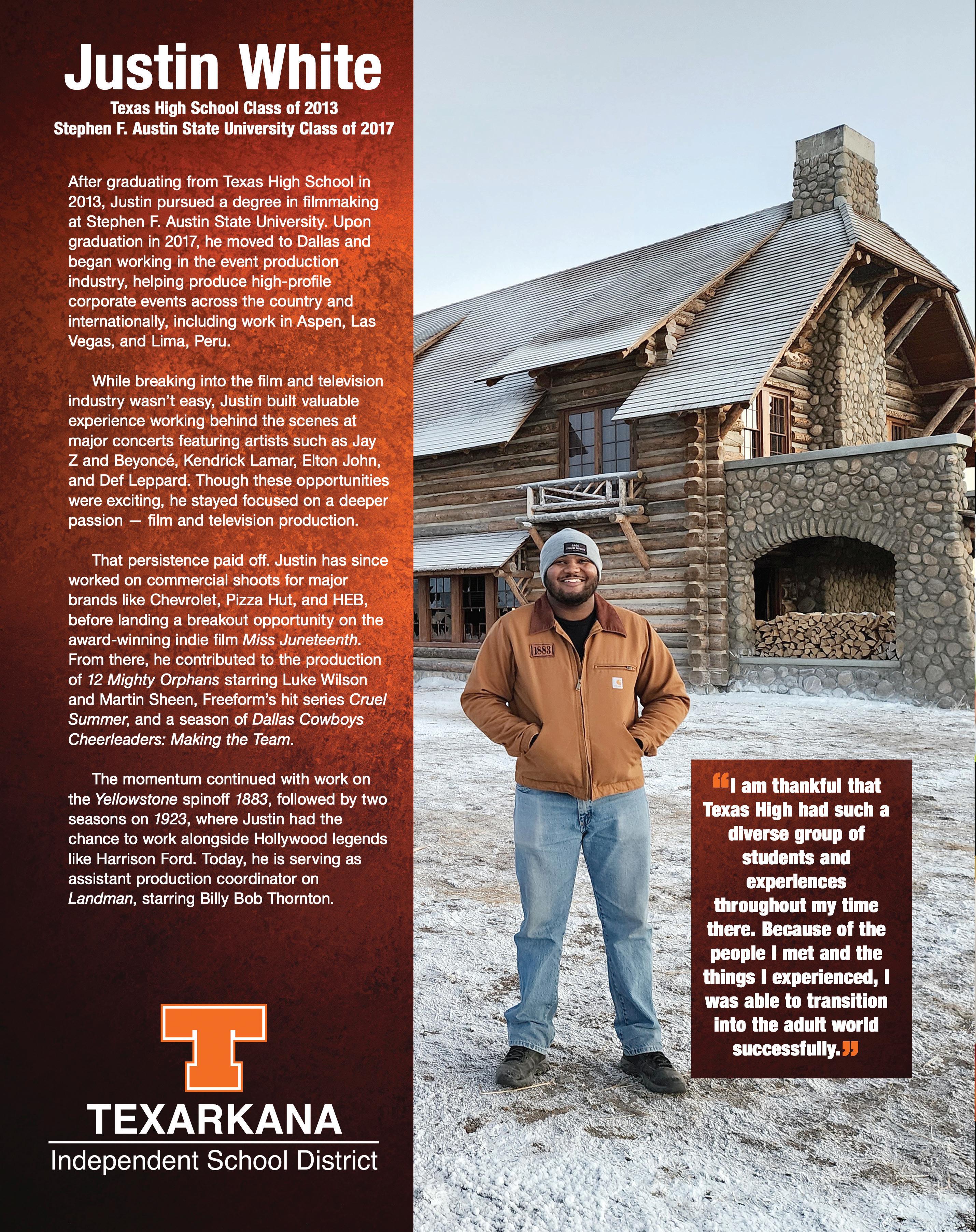

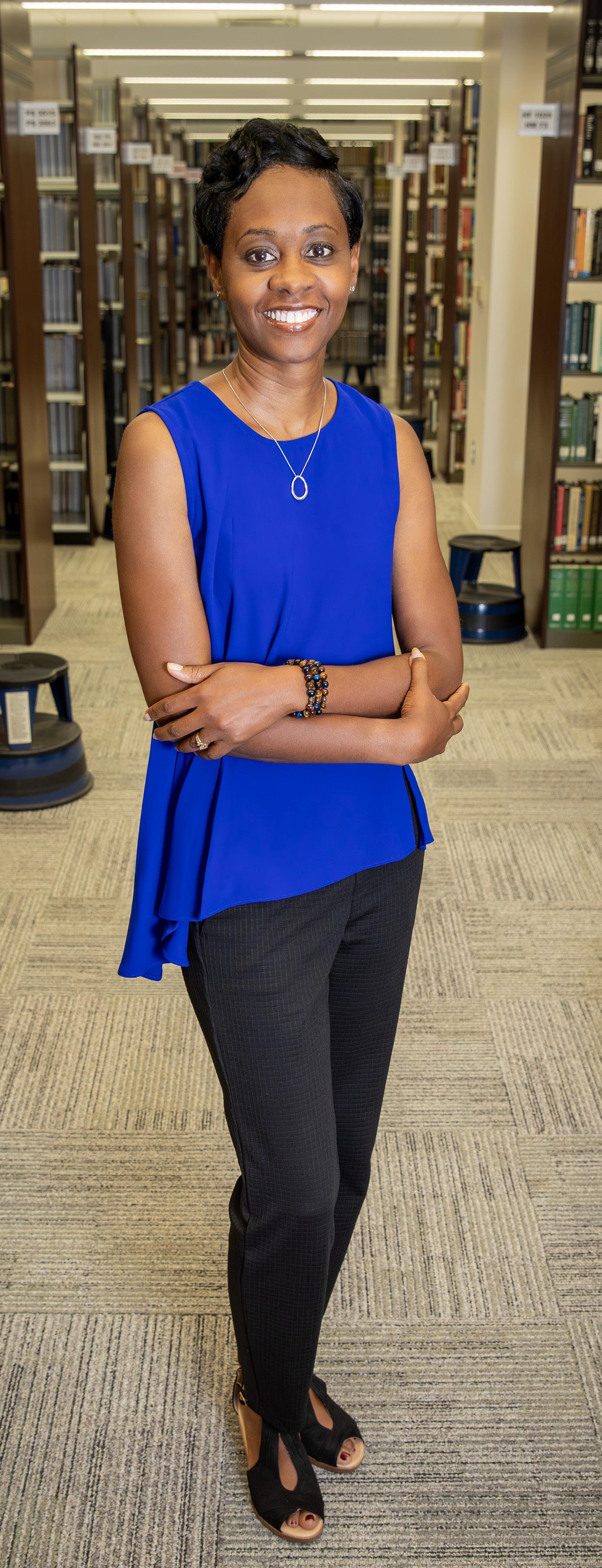
Acclaimed educator Monica Washington is named National Education Association’s Director of Teacher Quality
by ELLEN ORR
Over Monica Washington’s 20-year career as an English teacher, one activity she developed stands out as particularly revolutionary: “Pie Chart of My Perspective.”
Monica would present a given topic or issue and then ask her teenage students, “Where do you get your information? What gives you your belief? What percentage is family? What percentage is reading? What percentage are your friends?” The exercise changed the culture of her classroom.
“Some of the students would say, ‘Oh, [my perspective is] 100% me,’” Monica recalled. “I’d say, ‘No, it’s not,’ and we’d think through that. And probably the percentages were wrong, but it was helping them make that shift and realize that everybody has a different pie chart. So then, in discussions with each other, they would say things like, ‘Oh, well, it’s okay. Don’t worry about soand-so; don’t get on her back or whatever. She just has a different pie chart than you.’ Figuring out how to teach them that took me a while, but once I did, it was magical.”
A native of Memphis, Tennessee, Monica taught for ten years in Memphis before moving to Texarkana with her husband, Ricky, who is a Texarkana native. She taught at Texas High School from 2007 to 2017, serving as a department chair for several of those years. In 2013, she was named THS Teacher of the Year. The following year, she was named the Texas State Secondary Teacher of the Year. To date, she is the only Texarkana teacher to have received the award, at either the elementary or secondary level, since its inception in 1957.
The award, granted by the Texas Association of School Administrators, enabled her to travel throughout the country and meet other dedicated teachers. “I had the opportunity to practice training other teachers and mentoring,” she said. “That really sparked another little bug in me that I didn’t know I had. Even as a first-year, second-year teacher, I always tried to be supportive of other teachers, but [the National Teacher of the Year Program] gave me an opportunity to do it in a more formal way.”
SHANE DARBY
by
Monica intended to stay in the classroom long-term. “In my mind, I was going to teach [in the classroom] for 40 years,” she said. However, in 2017, a fellow member of the National Network of State Teachers of the Year (NNSTOY) sent her a job listing with a company called BetterLesson, which provides professional development and teacher coaching to districts throughout the country. Monica worked for them for over five years, providing
individualized support to teachers and helping districts develop highquality professional development for their schools. In her first three years with the company, Monica was coaching around 50 teachers per year.
“[BetterLesson] gave me an opportunity to coach teachers in all these different districts, one-on-one,” she said. “I would say, ‘Show me what you don’t know how to do. Let’s look at your papers. Let’s do all the things.’ I would always say to them, ‘I’m your person.’”
Outside of BetterLesson, Monica facilitated trainings and presented keynote speeches, connected to opportunities through NNSTOY. She seized chances not only to teach but also to learn; as a result, she discovered a desire to work in education policy.
“I remember, as a first-year teacher, thinking, ‘[Policy is] not my lane. I’m teaching. There are other people who will make sure that things are great for kids,’” she recalled. “But then I got a chance to go talk to people at the Department of Ed and the White House, and through all of these different experiences, I realized, ‘Oh, people have other agendas.’ So then I wanted to know how I, as an educator, could put my voice in-play for policies that are beneficial for kids and beneficial for teachers.”
In a move that “people thought was crazy,” Monica left BetterLesson to be a policy fellow through NNSTOY. Taking a pay cut, she worked with three other fellows to “learn all the policies,” she explained. “Our goal was to support other teachers who didn’t have time to do that, to help them understand what’s happening, what’s changing in their states. How can you still teach in a way that is beneficial for kids? So we developed tools and resources and workshops, and we talked to legislators, and we talked to the media. We wrote op-eds and blogs,
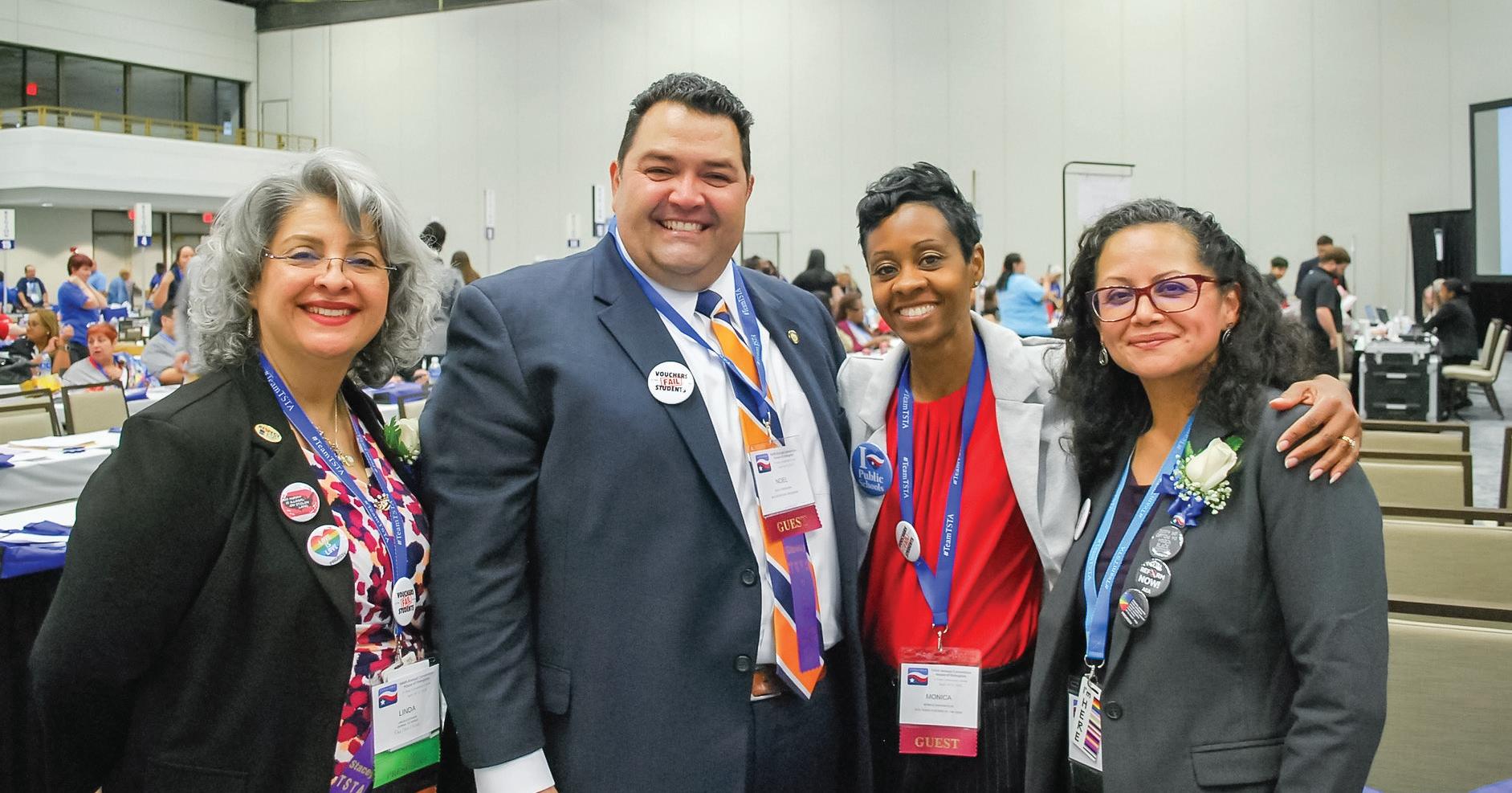


just trying to get the word out—about policies that are good for students and teachers, and policies that are terrible.”
During this time, in 2023, Monica was inducted into the National Teachers Hall of Fame; only five educators per year receive the honor.
After the 18-month fellowship, Monica began teaching at REACH University. REACH enables school employees like custodians, cafeteria workers, bus drivers, and classroom aides to earn teaching degrees while retaining their jobs. Aspiring teachers train at their current places of employment, take classes at night, and commit to teaching at their schools for a set number of years.
In early 2025, the National Education Agency (NEA) posted a job listing for the Director of Teacher Quality.
“They had been trying to find the right person, and with all the layoffs at the Department of Ed, they were being flooded with applications—like 300 per week,” Monica said. “But they were trying to find a unicorn—somebody who had a bunch of teaching experience, who also knew how to coach, who also understood policy, who also understood equity.” When a friend from NNSTOY told Monica that she was the person for the job, she balked—but after reading the listing, she thought, “Oh, that does kind of sound like me.”
A representative from the NEA actually reached out to Monica before she could even apply. Her name was added to a short list of chosen candidates, and after multiple rounds of interviews, she was offered the job. The organization had intended for the director to be based in DC, but for Monica, they made an exception; she will travel to her Washington office for multiple days each month but otherwise work remotely.
Monica’s team supports “everybody who touches education”— aspiring teachers, current teachers, and retired teachers. “It’s a huge job,” she said, “and I have no idea what I’m doing yet.”

Her first aim is to uncover where teachers are and aren’t engaged with or being served by the NEA, which is the nation’s largest labor union, with over 3 million members. One region with very low NEA membership? Texarkana.

All over the place, there are educators who are showing up with heart—and in many cases, those people are the reason that kids are okay. “ ”
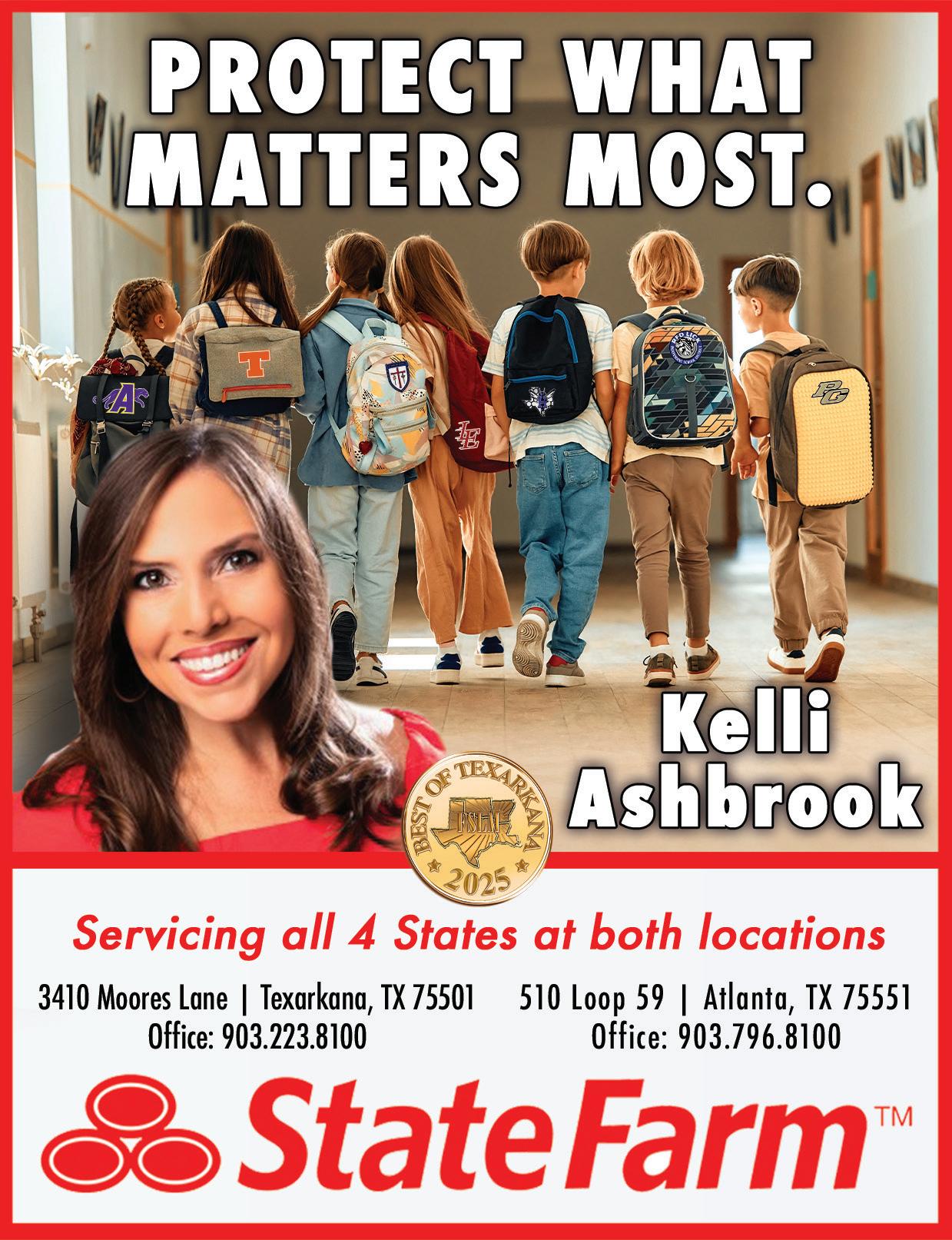
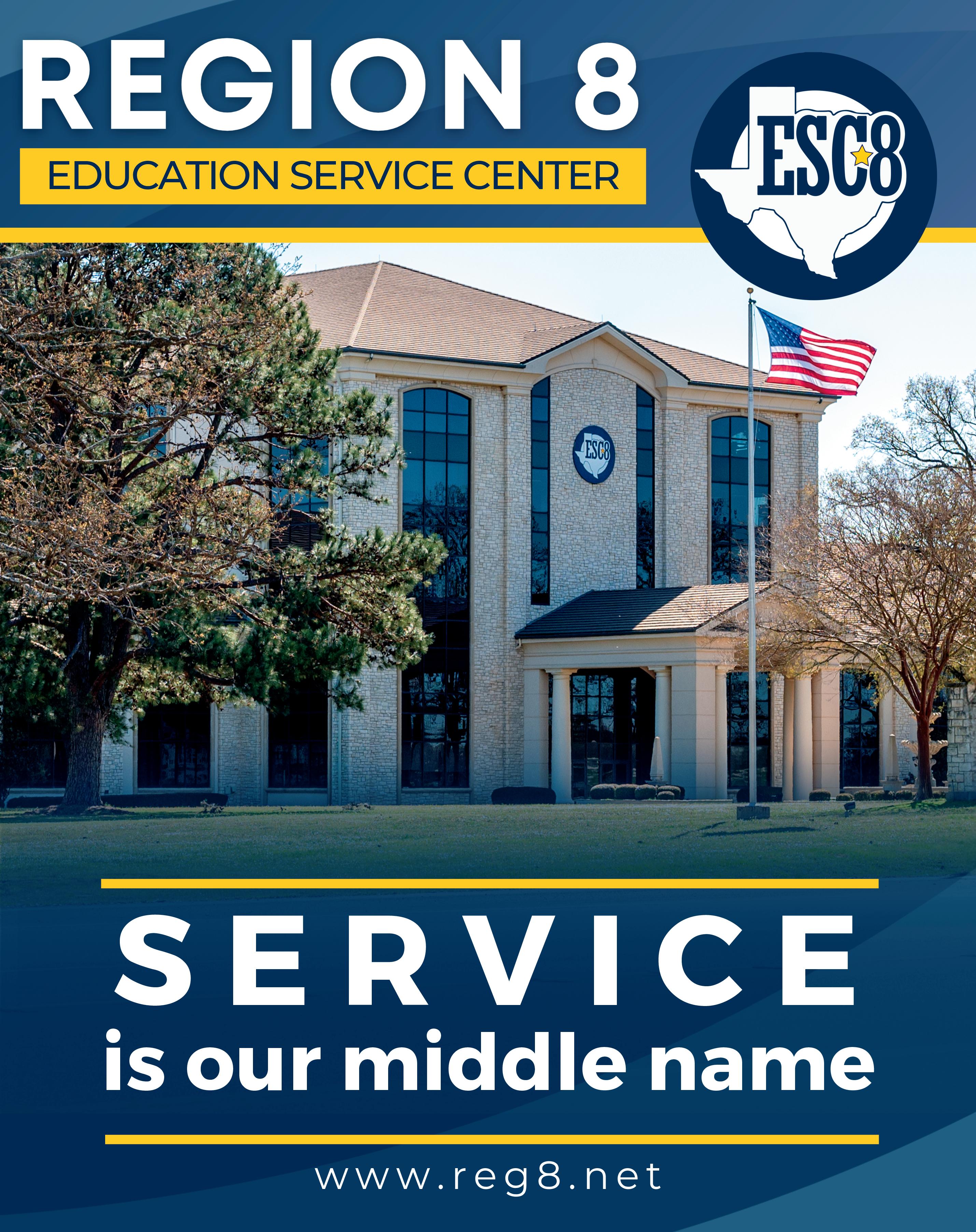

Monica recalled a local teacher once asking her for help with an issue they were having. Monica reached out to the Texas NEA office in Austin, and they helped the teacher in need. “After that, I asked [the teacher], ‘Why don’t you join [the NEA]?’ And she was like, ‘Well, I don’t know how I feel about being a part of a union, but I appreciate your help,’” she shared. “There’s a perception that it’s this machine that’s controlling everything, but when you go behind that perceived curtain, there are actually just educators who support other educators.”
People who have strong opinions about education would be well served by Monica’s “Pie Chart of My Perspective” activity.
“Before we attach ourselves to a negative perception, we should take the opportunity to go and look in two or three more places to verify what we heard,” she said. “Where else did you hear it? Are those credible [sources]? If you haven’t been in a school and haven’t talked to teachers about what’s hard, do it—have a conversation. The sensational news is just that—it’s sensational. But all over the place, there are educators who are showing up with heart—and in many cases, those people are the reason that kids are okay. Just take a couple more steps to see what is real, and know that it’s okay if you change your mind about something. Look for opportunities to prove something negative wrong.

“Of course, you can probably point to one or two people who should have been gone yesterday, who don’t really have their hearts in it,” she continued, “but your vast majority of teachers and principals are working so hard. It is a job that does not fit neatly within a work day; it bleeds into the weekend, it bleeds into the evening. It bleeds into your pockets when you’re, you know, buying prom dresses and feeding kids. These are the human beings behind every insult that we make about public education, human beings who get up every day to support other people’s kids, and who love doing that, who dedicated their lives to doing that.”




THE ANNIKA WOMEN’S ALL PRO TOUR GOLFERS HELD A CLINIC FOR SPECIAL FRIENDS OF THE RUNNIN’ WJ RANCH AT NORTHRIDGE COUNTRY CLUB ON TUESDAY, JULY 8TH.

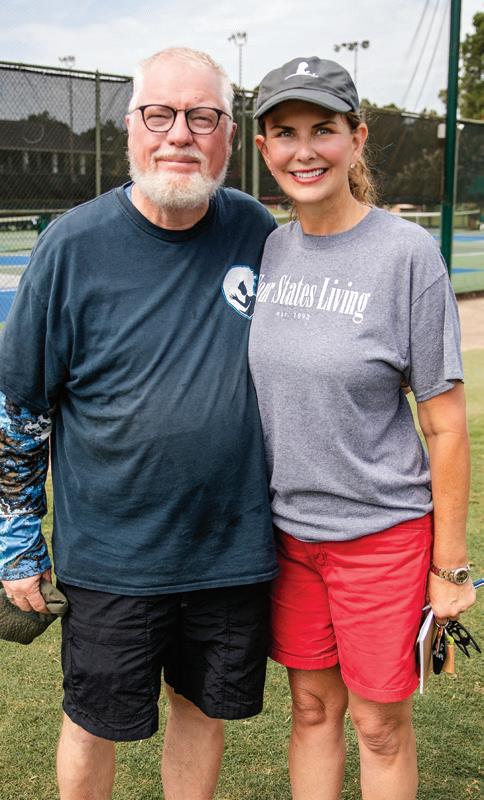

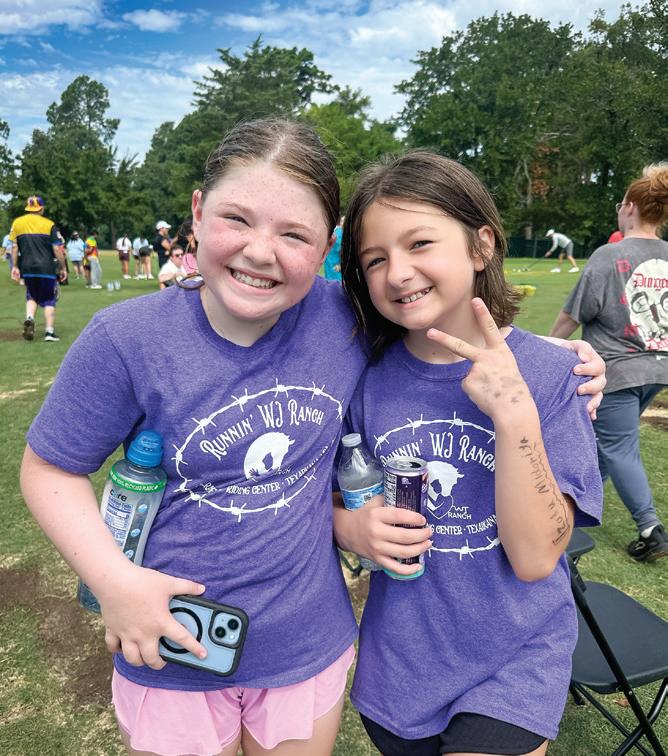
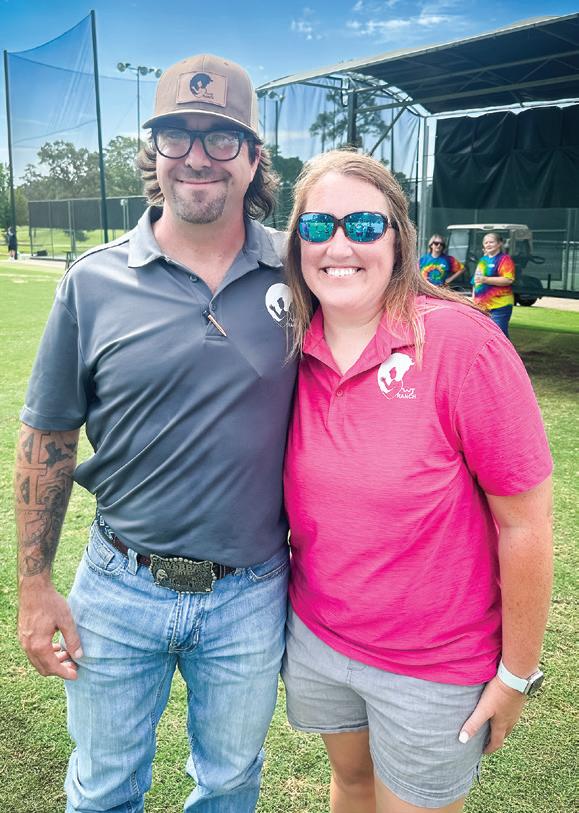
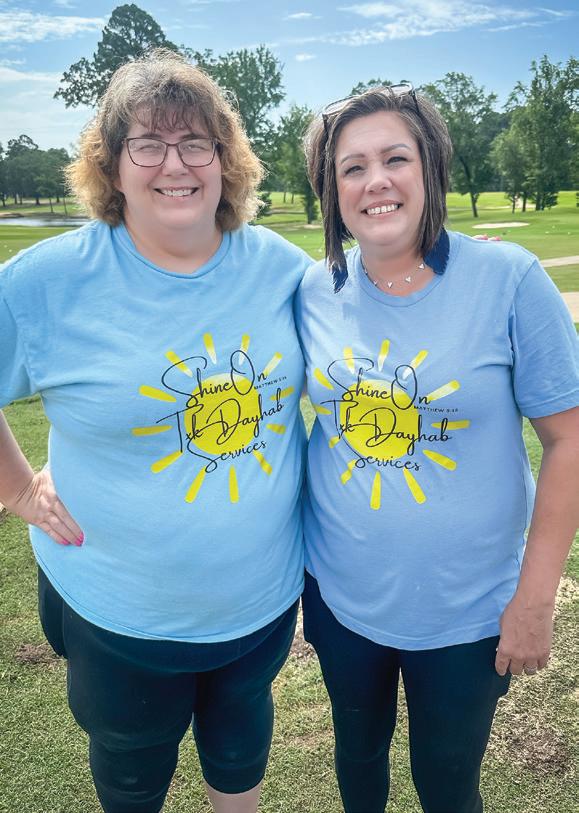
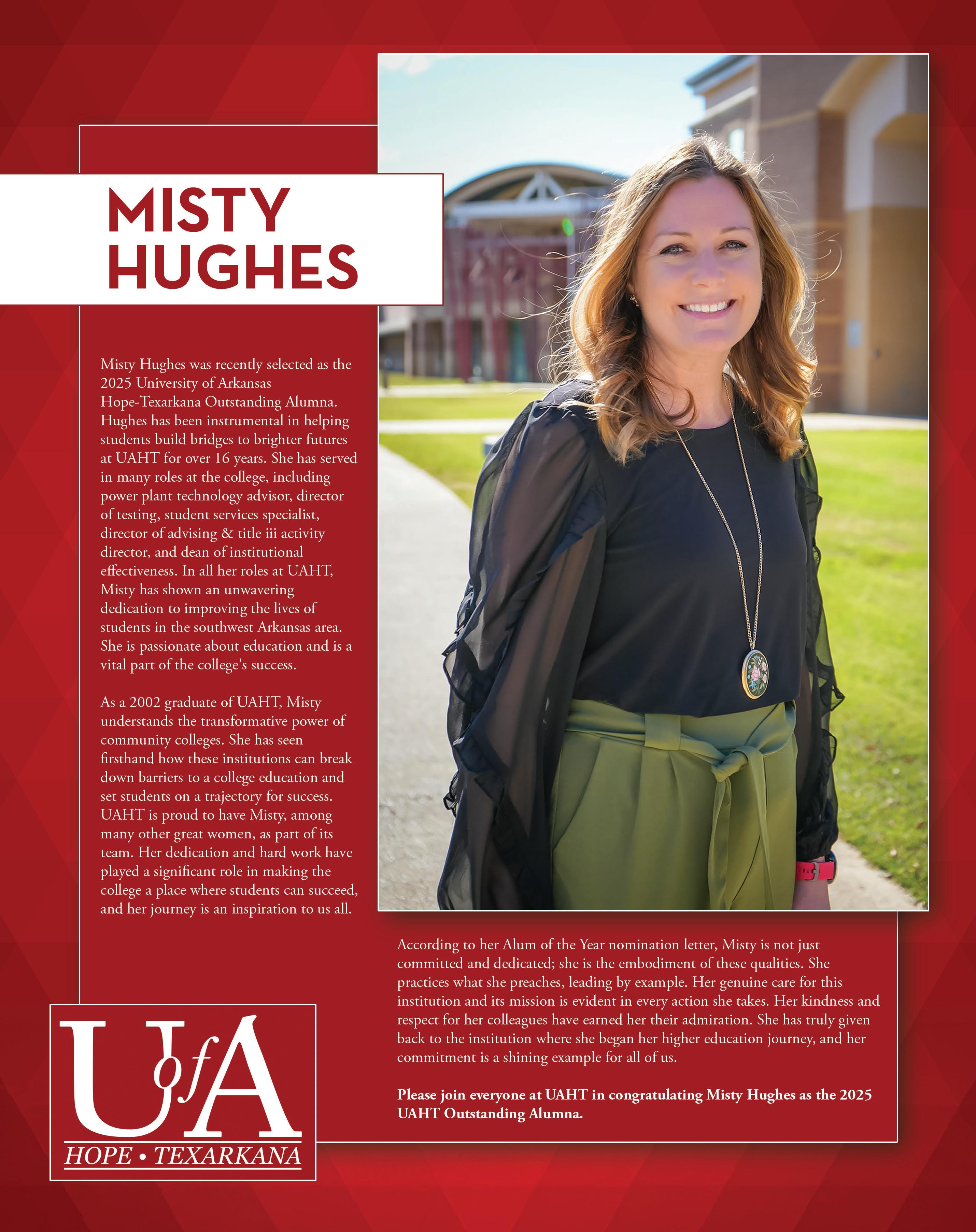

Broken Bow, Oklahoma, is a popular destination for those seeking to unwind in nature. The expansive, sparkling waters of Broken Bow Lake are surrounded by a national forest, and the Mountain Fork River—winding in and out of the lake—offers ample fishing opportunities. Another notable draw of the area is the abundance of cabins that offer serene views of the wilderness while providing all the comforts of home.


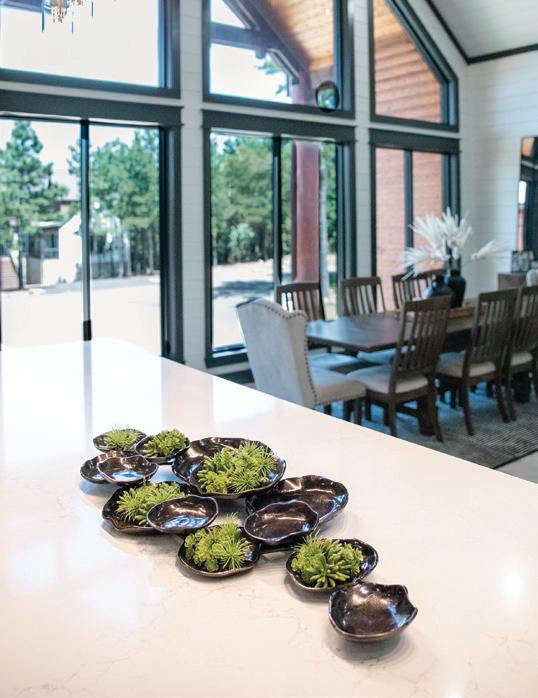





Jill Rowe, owner of Rowe Casa—a beloved line of health and wellness products—purchased one such cabin last February. This six-bedroom, sevenbath retreat rising from the trees is the perfect getaway for Jill and her family to escape the hustle and bustle of city life. While the structure was in excellent condition, the interior felt outdated and didn’t suit Jill’s aesthetic preferences. She had the cabin completely remodeled and brought in Texarkana-based interior designer Alicia Woodle to decorate and furnish the space.
Jill explained that, while she had a general vision for the interior, she enlisted the help of her sister to nail down the details. “I just sort of let her loose on Pinterest, and the pictures I liked I sent to Alicia,” she said. The result is a thoroughly modern aesthetic—clean, crisp lines; a neutral color palette of black, white, and gray; and sleek steel appliances throughout.




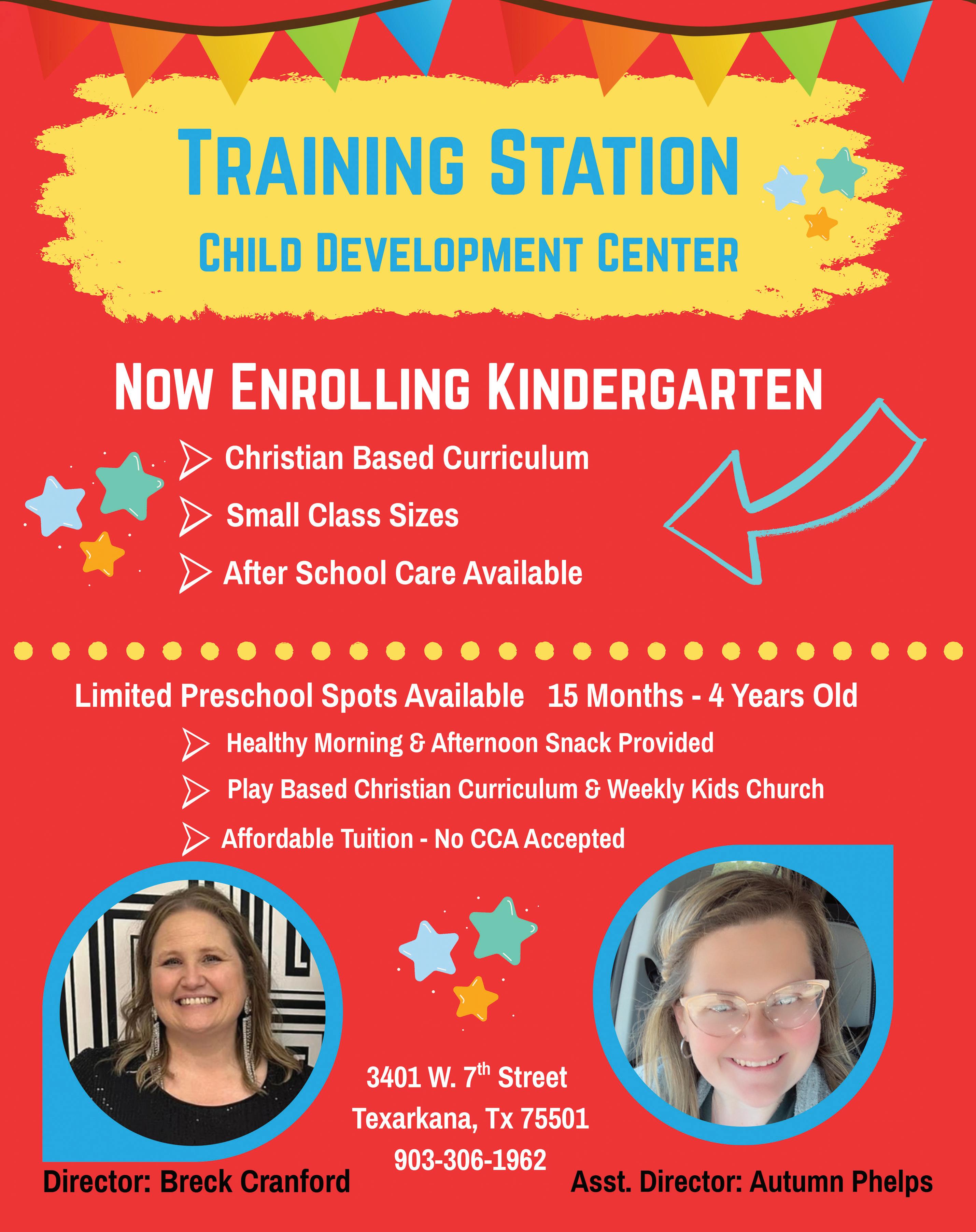
Each floor features an open-concept design, with kitchens and living spaces flowing seamlessly into one another. Bedrooms and bathrooms are tucked away at the sides to maintain the home’s spacious feel. Functional areas such as the kitchen and bathrooms are stocked with Rowe Casa products. Clean lines, minimalist decor, and small touches of greenery promote a calm, harmonious atmosphere.
A few spaces in the cabin are designated specifically for entertainment and relaxation: a game room features ample seating and a pool table, while a theater room is tucked away with leather recliners, a movie screen, and a snack bar.




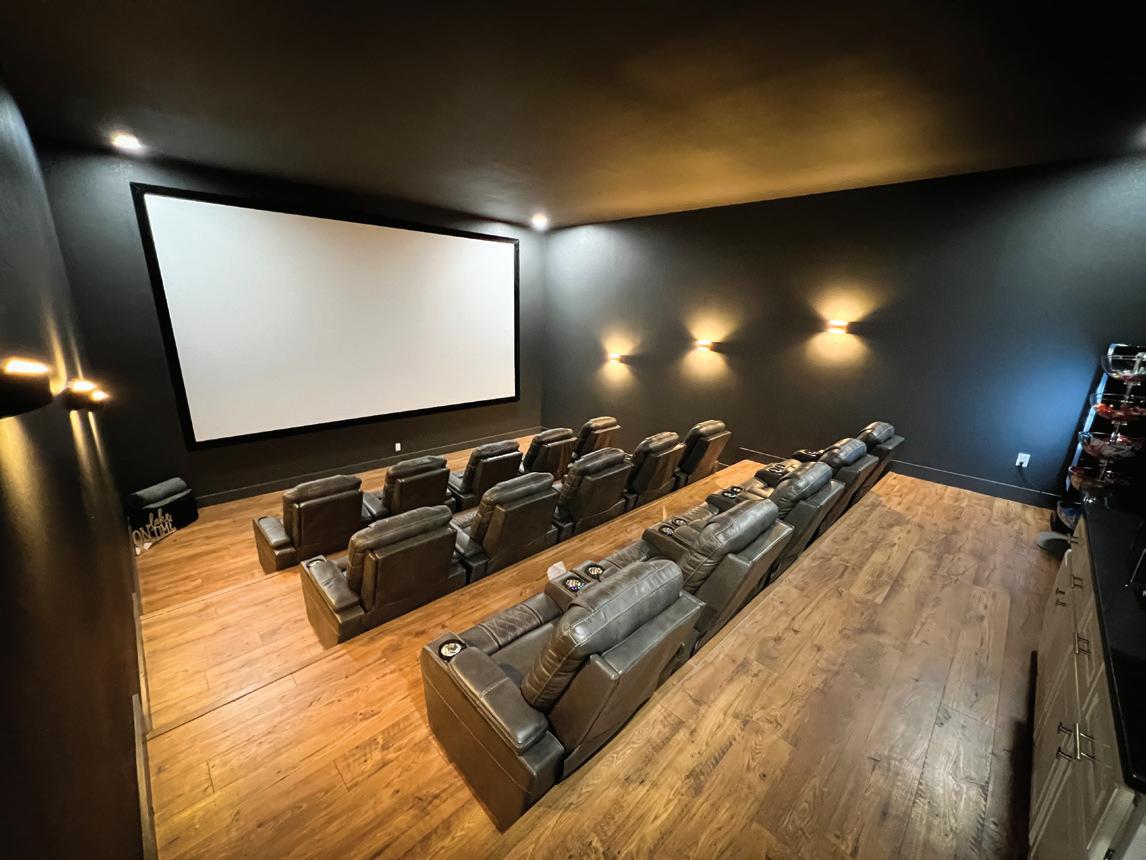


The cabin is as functional as it is beautiful. The kitchen is a prime example of this blend: stainless steel appliances are built into the kitchen islands to avoid disrupting the flow of movement, and barstool seating is neatly tucked into one side of the island to prevent clutter. The mudroom nook under the stairwell provides a tidy space for coats and shoes. A clever bonus is the bunk room, where stacked beds are built along a staircase-style frame, offering multiple sleeping spots without taking up too much space. At the top of this bunk structure is a cozy attic room, where Jill’s youngest daughter enjoys a private hideaway of her own.


Generously sized porches and balconies extend from both main levels of the cabin, where the modern aesthetic gently yields to the natural beauty beyond. These are the spots Jill gravitates toward when the weather cooperates. “My favorite space would have to be one of the balconies,” she said. “It’s great to hang out there and enjoy nature.”

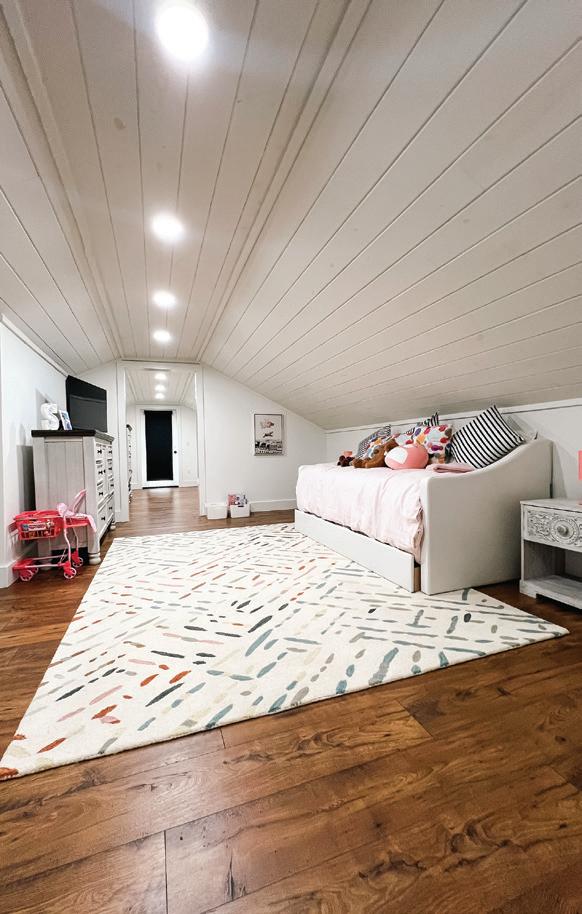

Standing on one of the cabin’s balconies, a soft breeze brushes past while cicadas and songbirds call out from the treetops. The serenity of the setting invites visitors to sink into a porch swing and take in the forest views stretching beyond the horizon. This tranquil space is a gorgeous gathering point—a chance to unplug from the grind and embrace the quiet comfort of nature.


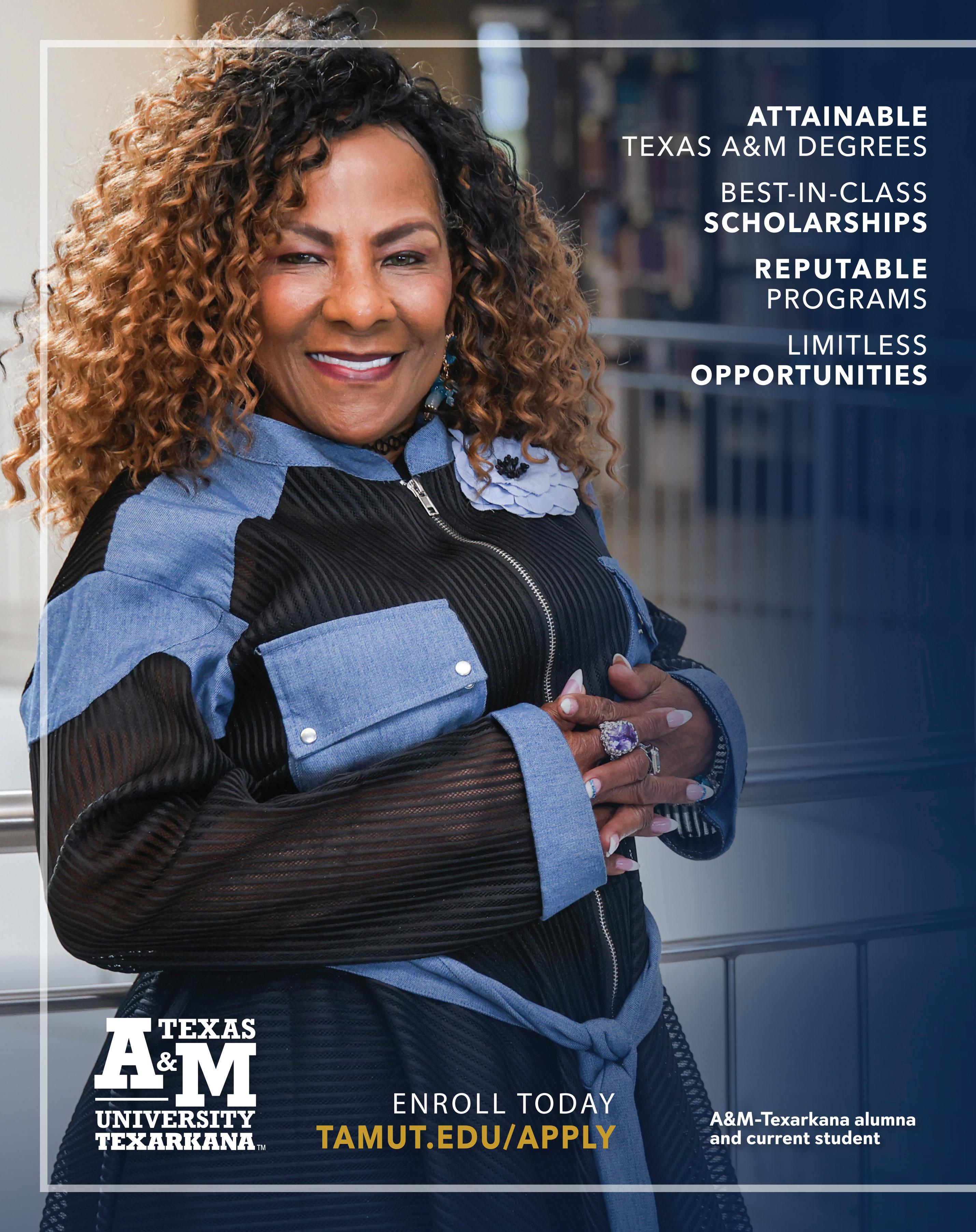

by JENNIFER JORDAN
Alove for educating children comes naturally to local teachers Daniela and Samuel Tirrito. On a given weekday, they spend time with a diverse range of ages, from Daniela’s elementary-aged pupils to Samuel’s high school students. Between them, Daniela and Samuel have a combined 30 years in education. Instructing, listening, supporting, soothing—an educator’s daily to-do list—all continue after the final bell, as they parent four young children of their own.
Samuel and Daniela both graduated from Texas High School, where Samuel has taught a variety of English courses for the past 11 years. Daniela’s students are at the opposite end of their K-12 years; she has taught pre-k, kindergarten, and 1st grade, all in bilingual classrooms. She worked at Texarkana ISD as an instructional aide while earning her teaching degree, which she obtained in 2010.
Daniela and Samuel’s schooling in TISD clearly made an impact on them, although each decided upon a career in education in their own way.
“It may sound cliche, but the teachers I encountered, both as a student and while working as an aide, profoundly shaped the educator I am today,” said Daniela, who was born in Mexico and immigrated with her family to the U.S. when she was young. “As an English learner, I will never forget the teachers who took the time and had the patience to support me and my family while we were still learning the language,” she explained. “Their compassion and dedication inspired me, and I strive to be that kind of teacher for my students.”
Choosing education was not as immediate for Samuel. As a teen, he worked with the school district in the summers as a custodian, a job he retained while studying at Texarkana College. He chose to become an English teacher because literature was something he loved and understood.


by SHANE DARBY
Both Daniela and Samuel’s commitment to the profession shines through their approaches to their students, which they learned from their own teachers.
“Building strong home connections has become a cornerstone of my teaching philosophy,” Daniela shared. “I remember how meaningful it was when my teachers reached out to my parents, and I carry that with me. Every time I call a student’s family, I’m reminded of those conversations I had with my parents after they spoke to my teachers. I know not all students have the same support system at home, and that makes my role even more vital—to be a consistent, caring presence in their lives.”
Samuel explained that a key tenet of his pedagogy is empowering his students to be critical thinkers. “I had a lot of strong teachers as I went through school, and that basis for critical thinking seemed to me to be the most important thing for students to learn—that if you had those skills, then you could do anything that you wanted to,” he said. “That still feels like one of the best things you could provide to someone else.”
The four Tirrito children range in age from 4 to 9, attend different schools, and have various afterschool activities and therapies. Clara, age 5, is a client at Temple Memorial Pediatric Center, the only local nonprofit provider of pediatric therapies. Clara was chosen as Temple’s 2025 Kid of the Year—an honor that reflects tremendous effort and progress.

I believe being a teacher has made me a better parent, and being a parent has made me a better teacher.
–Daniela Tirrito “ ”

Daniela said that the title has helped build Clara’s confidence. “Clara works hard; any time you try to teach her something, she is excited and willing to learn,” Daniela explained. “She keeps trying until she knows she has done her best. Her therapists do an outstanding job at telling us what they have done in therapy with her, and we try our best to continue practicing those skills at home.”
Clara represented Temple Memorial recently at its annual golf tournament. “She talked about it for weeks,” Samuel said. “She was so excited to get to wear her purple
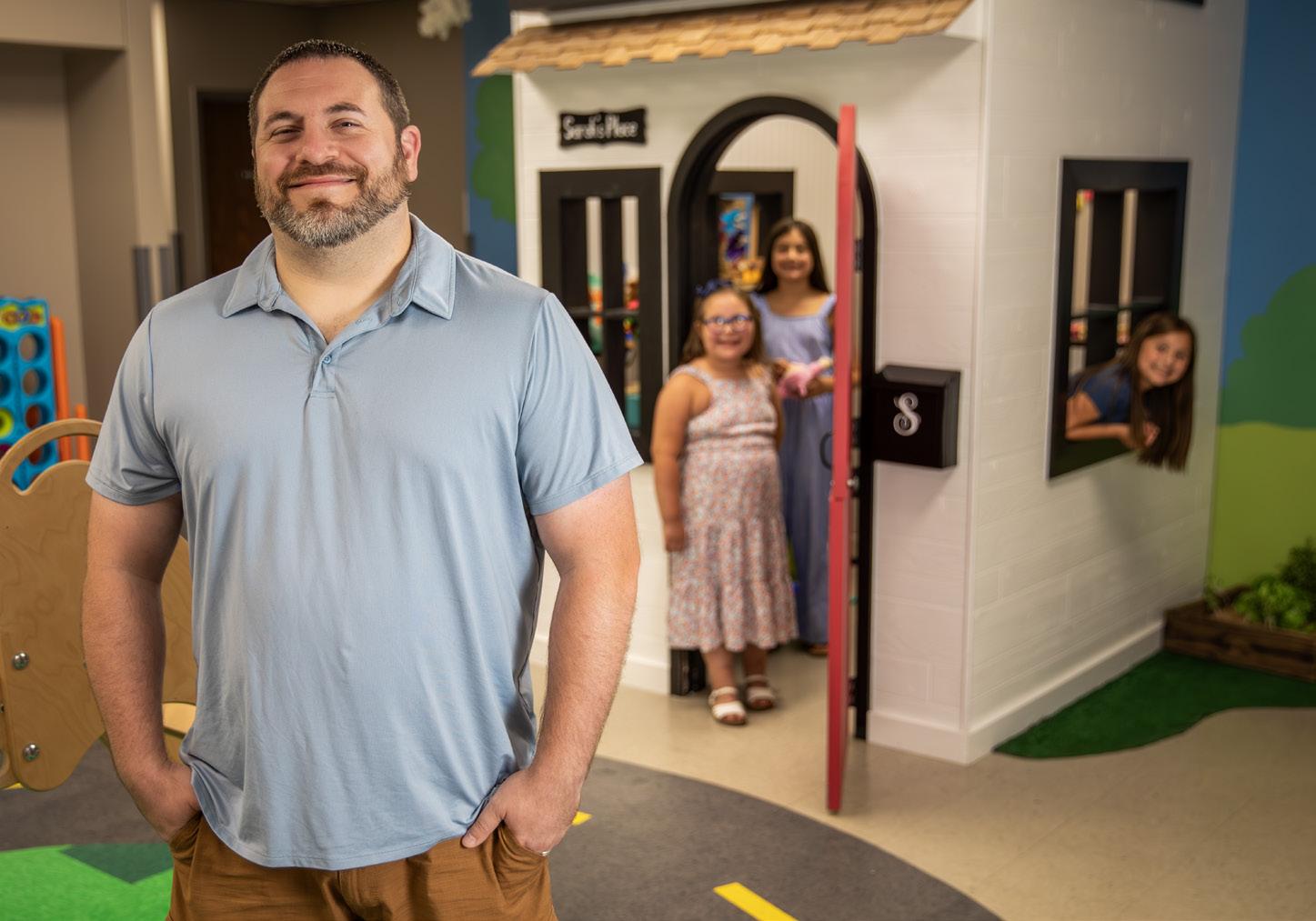
I want my kids to be able to think for themselves—that’s the main thing. –Samuel Tirrito “ ”

shirt, and she was ready to go play golf as well. Clara loves getting attention, and a lot of family and friends showed up for her out there, and you could tell that she knew it.”
Daniela said that her career as a teacher has helped shape her approach to parenting. “I believe being a teacher has made me a better parent, and being a parent has made me a better teacher,” she reflected. “Working with children every day has taught me the value of strong communication, encouraging curiosity, and nurturing creative thinking—skills I prioritize both in the classroom and at home. I’ve also seen how much students benefit from structure and clear expectations, which has reinforced the importance of providing the same kind of consistency and guidance for my own children.”
Samuel believes that he would parent the same way, regardless of his profession. “I want my kids to be able to think for themselves—that’s the main thing,” he said. “I try to ask them a lot of questions, and since I do that in the classroom daily, maybe I am a little better at it than I would be otherwise.”
When school resumes in August, Daniela is excited to begin a new job teaching third grade language arts at Pleasant Grove Intermediate School. Samuel noted that their morning routine will probably have to adjust itself—“The recent I-30 changes will make it a lot more interesting in the fall,” he quipped. No matter, the Tirritos will figure it out, as they continue to develop young minds and hearts at home and in the classroom.



Camille Sherman connects international students with local host families—and hosts students herself
by PHOEBE WARREN
For Camille Sherman, the world got pleasantly smaller when she welcomed a 15-year-old boy from Denmark into her home. In 2022, Camille and her husband, Kevin, had flown out from their hometown of Atlanta, Texas, to join a business trip with Kevin’s boss. During the trip, Camille recalled, the boss was completing paperwork to host an exchange student and asked if he could list the Shermans as a reference. “The very next day, the coordinator called and talked to Kevin,” Camille said. “He asked if we would be willing to host. So we got our first exchange student in the school year of ‘22 to ‘23. His name was Alexander Bodholdt, from Denmark.”
It must have been fate that brought Alexander into the Shermans’ lives because the experience left a lasting impact on the whole family. “He came in and basically fit right in with our family,” Camille said. “He was always up for anything that we did, willing to try all the foods that we had, and was a normal teenager. He made many friends in school and was always on-the-go.”
Alexander made an especially big impression on Camille’s son, Kyson, who was 13 at the time. “Having that older brother [figure] around was so good for Kyson,” Camille explained. “We saw Kyson mature so much in the first year.”
by
That first hosting experience lit a fire in Camille’s heart. “I knew that it was something that I wanted to continue to do, to enable the students to have a wonderful experience while in America,” she said.
After hosting two more students, Camille felt called to take a bigger role. She became a local coordinator for Foreign Links Around the Globe (FLAG), a US-based nonprofit international exchange organization that places over 500 students each year from more than 25 countries into American homes.
As a FLAG coordinator, Camille recruits host families, helps match them with students, and supports everyone throughout the student’s stay. Her work goes beyond social media outreach; she personally connects with families and students to ensure a good fit. “A lot of times I will look for a student with interests that I know a family may have,” she said. “For instance, I currently have a student that loves to play the trumpet, so I have geared him towards my band parents so that he may join the Big Bad Band from Rabbit Land [Atlanta High School band’s nickname].”
Once a family expresses interest, Camille helps guide them through the process: background checks, an in-home visit to confirm the living situation, and coordination with the student’s future school. After approval with the school in question, the host family is able to communicate with the student until they arrive.



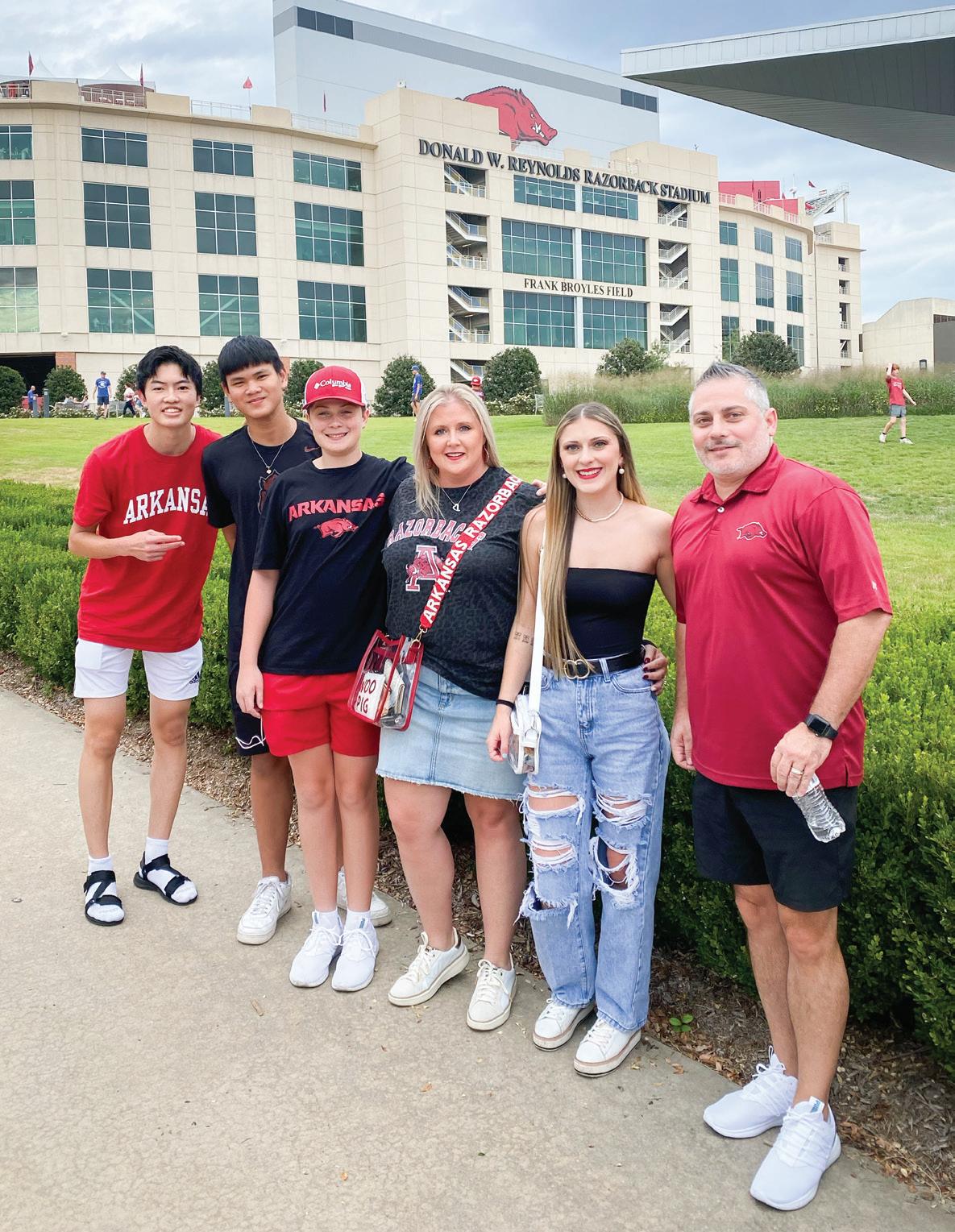

Since joining FLAG, Camille has welcomed five students into her own home, each leaving behind lasting relationships. Kevin notes that every student has been “just like having another child in the house,” but with an extra lesson attached. “It opens your eyes to how people live around the world,” he said.
Each student brings a new precious memory to the Sherman family’s story. Jirapat Pooseengoen, from Thailand, and Haruto Tomita, from Japan, attended an Arkansas Razorbacks football game with the Shermans and were amazed at the chance to see American football. Two other students, Raiku Saarikallio, from Finland, and Line Widera, from Germany, got to attend a Dallas Stars hockey game. That trip was made even more memorable when Raiku’s cousin, Miro Heiskanen, player #4 for the Stars, skated over to the glass and tossed Raiku a puck.
The Shermans keep in contact with each student they’ve welcomed. A few have even come back for visits. Even with the cultural adjustments— ”Texas heat!” Camille laughed, along with the frequency of dining out in America—most students adapt to their new surroundings quite swiftly. “Most of the students are very excited about learning American culture,” Camille said. “They are excited to get the experience of all the school activities and sports that each school may offer. Most of our exchange students do not have any type of dances [in their home countries], so prom is definitely a number-one thing that they are excited about experiencing.”
Camille and the rest of her family encourage others to open their homes and hearts to exchange students. “[Living with an exchange student] can teach you patience through the culture differences and language differences,” she said. “I believe just seeing the world in a different way than what we see here in America is important.”



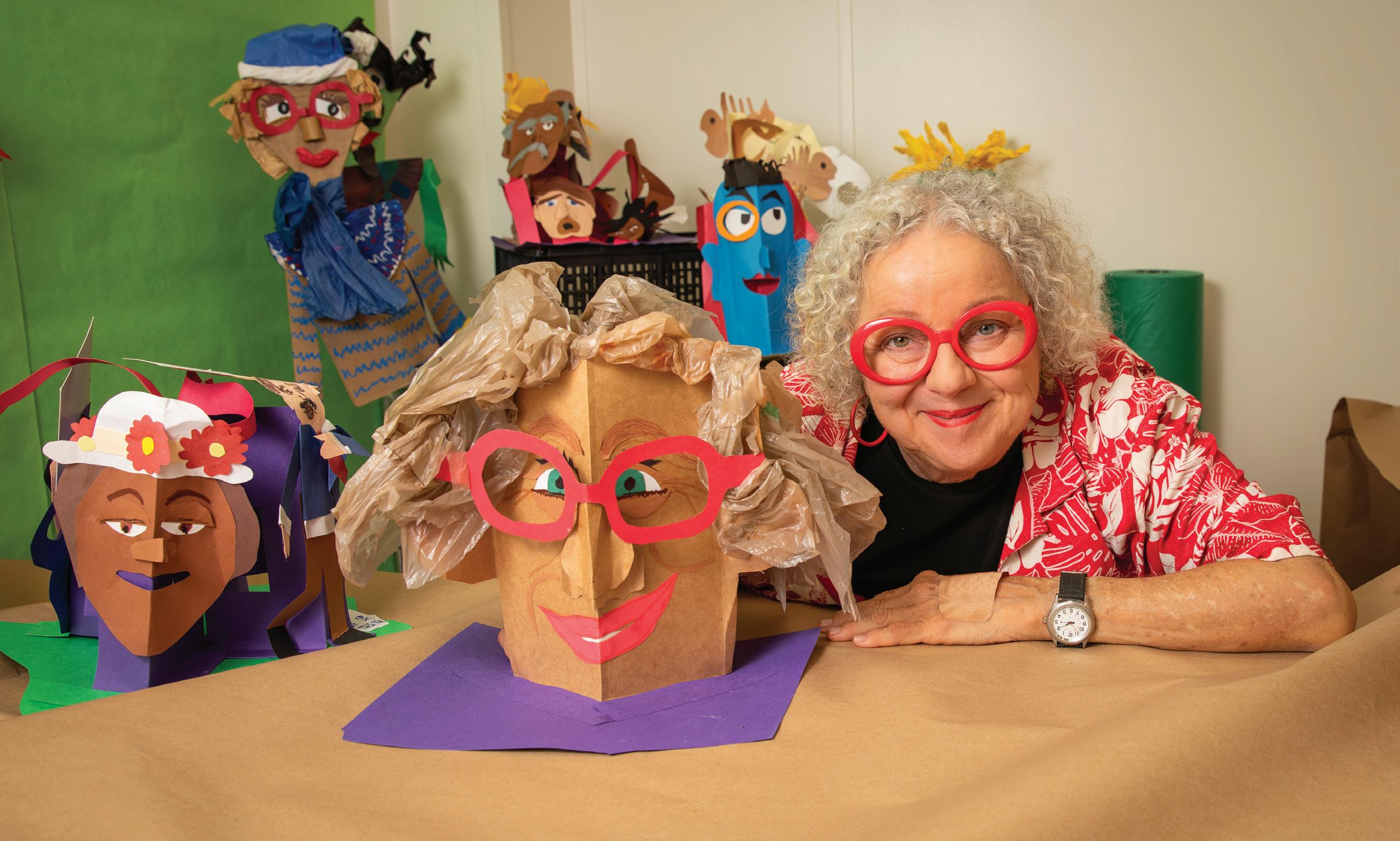
Artist Kay Thomas inspires others to “reclaim their right to create”
by BRANDON SHOEMAKER
At 71, Kay Thomas is busier—and bolder—than ever. A lifelong artist, educator, provocateur, and national arts integration specialist, Kay doesn’t show any signs of slowing down. In fact, she seems to be hitting a new creative stride.
“I’m at the top of my game,” she said. “I know how to build pretty much anything I want to build. It’s just—do I have the strength to do it? But I never expected my career to explode with such success at age 71.”

Strength, it seems, is no problem. In between sculpting, lampmaking, working with teachers across the country, consulting for the Kennedy Center, and dreaming up her next wild artistic project, Kay is shaping not just clay and paper but also minds. From her roots in East Texas to classrooms and studios nationwide, she’s always been on a mission: to move people to create, especially when they think they can’t.

by SHANE DARBY
Kay’s journey began in Texarkana, Texas, where she was raised in a creative household. Her father, an architect, brought home sand for her to play in and took her to construction sites, which fostered an early-developed appreciation of architecture as an artform. By the time she was 3, she was already drawing, painting, and digging up clay to turn into sculptures.
“I was both 2D and 3D from the very beginning,” she said. “My art historian brother said, ‘You didn’t have a choice. You just were an artist.’”
Kay’s mother, a third-grade teacher, was a strong advocate for her artistic drive and introduced her to the concept of the teachable moment. She modeled in her own classroom how the arts could be woven into education—a philosophy that Kay would later adopt and expand into a national career.
Ceramics became her primary medium in high school. “I came home and told my mom, ‘This is it. It’s clay,’” she recalled. She went on to earn a BFA and an MFA in ceramic—one of only five students chosen out of 200 applicants to attend Arizona State’s graduate program based on her portfolio.
Describing her style, Kay laughed: “A professor once told me I’m a ‘Funk Mannerist.’” The label fits. Her work is unapologetically loud, funny, and layered in meaning—what she calls a celebration and satire “of American consumer bad taste.” A small sampling of her works: a lamp adorned with cats, complete with cat paws as the feet of the lamp; a monument to Tammy Faye Messner (Bakker) featuring mascara-wielding cherubs; and a Bill Clinton–inspired lamp (the shade reads, “I did not have sex with that woman,” and when lit, reveals, “I have deceived everybody, even my wife.”).
“I love kitsch,” she said, “because it exists on the same extreme as great art. It’s over-the-top.”
Over the decades, Kay has crafted monuments to presidents, pop icons, pets, and TV preachers. Her political lamps are biting and hilarious. Her cat reliquaries and her plans for a killer poodle sculpture are equal parts sentimental and disturbing.
Each piece is both a technical feat and a statement, requiring engineering savvy and a deep understanding of art history and symbology. “It can take me years to get the iconography just right,” she said.
But Kay is not content to make art for art’s sake. She’s an artist who teaches other teachers how to foster connections across the curriculum for their students.
While working as an artist-in-residence, Kay began noticing a trend: “Teachers were missing tons of teachable moments,” she said. She saw countless opportunities for students to make connections between art and writing specifically. “They never had kids write out a step-by-step of how they made the art . . . or a persuasive paragraph about why someone should buy your art,” she recalled, “and that bothered me.” So when she was approached by the Texarkana Regional Arts and Humanities Council (TRAHC) to work as an arts integration consultant, she knew this was the right move for her.
After Kay became their arts integration consultant, TRAHC partnered with the Kennedy Center, and Kay was chosen as one of a select few teaching artists to join the Kennedy Center’s national roster. Through that role, she has helped educators use the arts—specifically visual and sculptural forms—to reach learners who might struggle in traditional classrooms.
Through TRAHC, the Kennedy Center, and Focus 5, a national collective of Kennedy-trained art specialists, Kay teaches teachers how
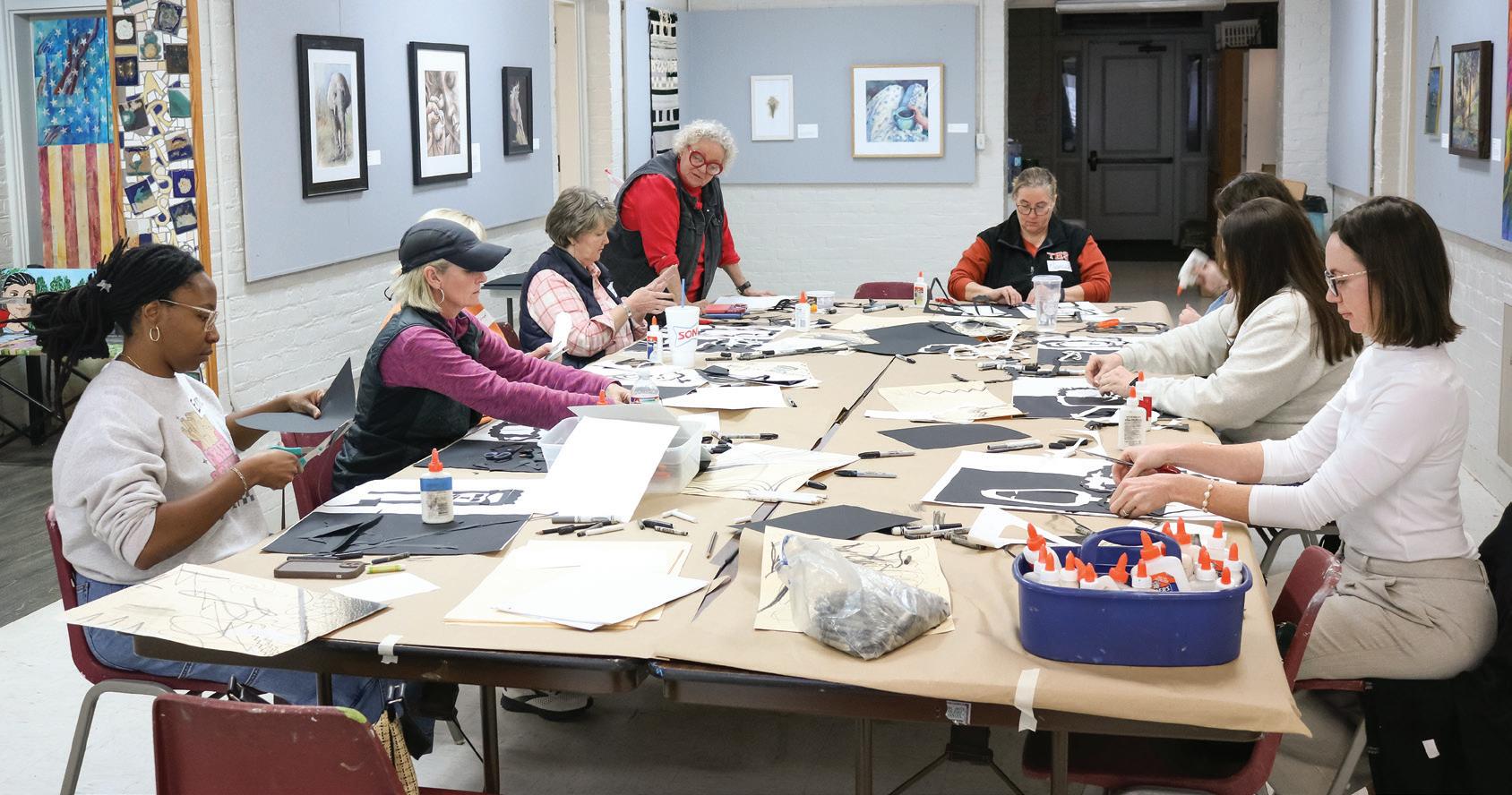


“My whole life as an artist has been to show people I could do it. I would look at clay things, and go, ‘Well, if that person can do it, I can do it.’
And that’s something I tell kids.”




to help students grasp abstract concepts—like plot structure, scientific classification, and historical context—through sculpture, puppetmaking, and creative writing based on portraiture. Arts integration is important for her because it “is about giving the nontraditional learner a voice,” she explained.
Kay’s workshops are part–professional development, part–stand-up comedy. She’s animated, candid, often eccentric— something that once seemed offputting to people but now is expected. “As an older artist, you’re almost supposed to be eccentric,” she said. “Now, it’s an asset.”
That eccentricity earned her the moniker of “The Electric Eel of Art.” The nickname was bestowed by a Mississippi school principal who said that Kay shocks people into creating when they think they can’t.
A Legacy in Laughter and Learning
Thomas has left her mark far beyond the gallery wall. In Texas, Mississippi, and across the country, her influence ripples through classrooms, arts organizations, and a generation of artists, students, and teachers.


Through it all, her message has remained the same: everyone is creative. Everyone can make art. You just have to reclaim the part of yourself that knew it as a child.
Considering the adults who come to her workshops afraid to pick up a brush, unsure of their own ability, she said, “I tell them, ‘Use your non-dominant hand.’ ‘Pour the watercolor.’ ‘Make a mess.’ I really want them to reclaim their right to create.” And they do.
Kay joked that her future plans involve being cremated and “sprinkled in several Walmarts and dumpsters where I’ve had a good fun time” (referring to diving for discarded refuse she uses as artmaking materials). But while she may need to outsource her dumpster-diving tasks these days, Kay is as lively and productive as ever and has no plans to slow down or narrow her scope.
“When I got my MFA, I didn’t want to be described just as a ceramist,” she said, “because I realized I was about more than just clay.” She’s also about theatre, teaching, costumes, satire, construction, conversation, and chaos.
Mostly, she’s about reaching people where they are, whether it’s in a third-grade classroom or at a national arts training institute, and giving them the confidence to make something.
Kay’s ultimate legacy, she hopes, will be one of instilling the confidence in individuals to believe that art is accessible to everyone and at any age. “My whole life as an artist has been to show people I could do it,” she said. “I would look at clay things, and go, ‘Well, if that person can do it, I can do it.’ And that’s something I tell kids.”
Kay Thomas isn’t just a working artist. She’s a force—an electric eel in a sea of predictability—still shocking people into art.


by EMILY GAMMON
ugust always arrives with bittersweet emotions for me. This year in particular, it feels more difficult to send half of my people back into their everyday school routines. This is the close-out of our first summer as a family of six. We lived every moment fully, acutely aware of our blessings and not taking one for granted. Still, I crave the routines of the school year. I welcome the anticipation of a fresh start, five months to go before we wrap up the calendar year as a whole—one final push to accomplish all the things we set out to do in January. My house is perfectly seated to hear our local high school marching band practicing in the early morning hours. When I can hear the drums and horns in the distance, it signifies that fall is coming—maybe not until October in Texas, but slowly and surely, we will get there.
One of my favorite parts of the back to school season is walking through the school supply displays. Of course they begin to stock the shelves obnoxiously early, but it doesn’t bother me. Yellow boxes lining the aisles with bright folders, fresh crayons, backpacks, and pencils. There’s the nostalgia of impatiently waiting for the school supply list. I explain to my children that there weren’t digital copies in the early 2000s; you waited until Walmart made copies and displayed them at the front of the store. There wasn’t an Amazon cart that delivered everything you needed in a click of a button with next-day turnaround. I could not wait to go shopping to perfectly curate my collection of supplies for the year.
Walking the aisles, you’ll note that the options and variety of items you can select from is unbelievable—and that’s not even including the endless online options. Take this bit of unsolicited advice from a former elementary teacher: keep it simple. If the brand is easily identified and has been around through generations of students, buy it. Think: Crayola, Elmer’s, Sharpie, Expo. All crayons, pencils, and dry-erase markers are not created equally.



Believe me, as a “save every penny you can” kinda girl, these are not the items to go off-brand on.
While I’m at it: if an item is scented, glittery, sequined, or has pop-its or any other variety of distracting add-ons, skip it. Your teacher will appreciate you.
When you get to the glue sticks, buy double. No—triple! They disappear, they dry out, and your child will lose the lid. Kleenex and hand sanitizer? Go ahead and double those, too. Mark my words: your teacher will be out of tissues by November, if not before. (Then they’ll start buying them out of their own pockets, so restock

them when you think about it!) There’s just something magical for a student about getting out of your seat to get a tissue. It’s a fix-all. Need a bandaid? Tissue. Sweaty after recess? Wipe your head with a tissue. Sneezy? Tissue. Loose tooth? Get a tissue. Wipe off your dry erase board? Everybody needs a tissue!
If you really wanna “wow” your new teacher, buy them several rolls of paper towels. That roll of brown construction paper that schools claim as paper towels is anything but. They do nothing more than spread and inexplicably multiply liquid.
Speaking of liquid: 2025 children need to bring water bottles. I don’t know when our kids got so thirsty, but apparently they need water. Your teachers don’t want to deal with water bottles, I assure you, but it is easier than your child raising their hand and asking 14 times to go get a drink from the water fountain, typically right in the middle of instructions of some sort. When you buy that water bottle, do your best to avoid the temptation of following trends. Your child needs something with a secure, tight lid—not a 64-oz stainless steel Stanley straw cup that can be heard three rooms over when it hits the floor and spills everywhere (refer back to my last point about the paper towels). Save everyone the hassle.
Do not—I repeat, do not—buy your child a handheld pencil sharpener. They are my least favorite school supply item. Not even the most perfect, angelic child can use one of them without spilling pencil shavings and graphite all over the classroom floor. And there’s some kind of sixth-sense phenomenon that happens: when one child has a sharpener, every other student knows and must borrow it. So then it is passed around, and detritus ends up in every corner of the room. Just don’t do it. Don’t.
Last but not least: get a backpack that can be thrown in the washing machine. Stop what you’re doing right now, go into your phone calendar, and create four alerts throughout the year to WASH THE BACKPACK. I’ll save you the horror stories, but you don’t want to know what kind of cooties and creatures come to school in the backpacks that hang right next to your child’s. I would never claim to be a mouthpiece for all educators on any subject, but I can guarantee that the suggestions above unify us all! As we get back into our routines and hit the ground running this August, I want our readers to know something else. I feel confident that Texarkana is home to the best educators around. I know many of them professionally and personally. Our teachers and administrators, no matter what district they serve in, love your kids and want to see them to succeed. Your child isn’t a number. They aren’t a test score. They aren’t identified by their different abilities. Your child is a vital part of our community. They are the next generation of thinkers, leaders, and world changers. When adversity and challenges arise this school year, as they always do, remember this one principle, which doesn’t just apply to buying school supplies but to all situations: keep it simple. Parents, you got this! Teachers, you got this! Students, you got this! Here’s to the best school year!

